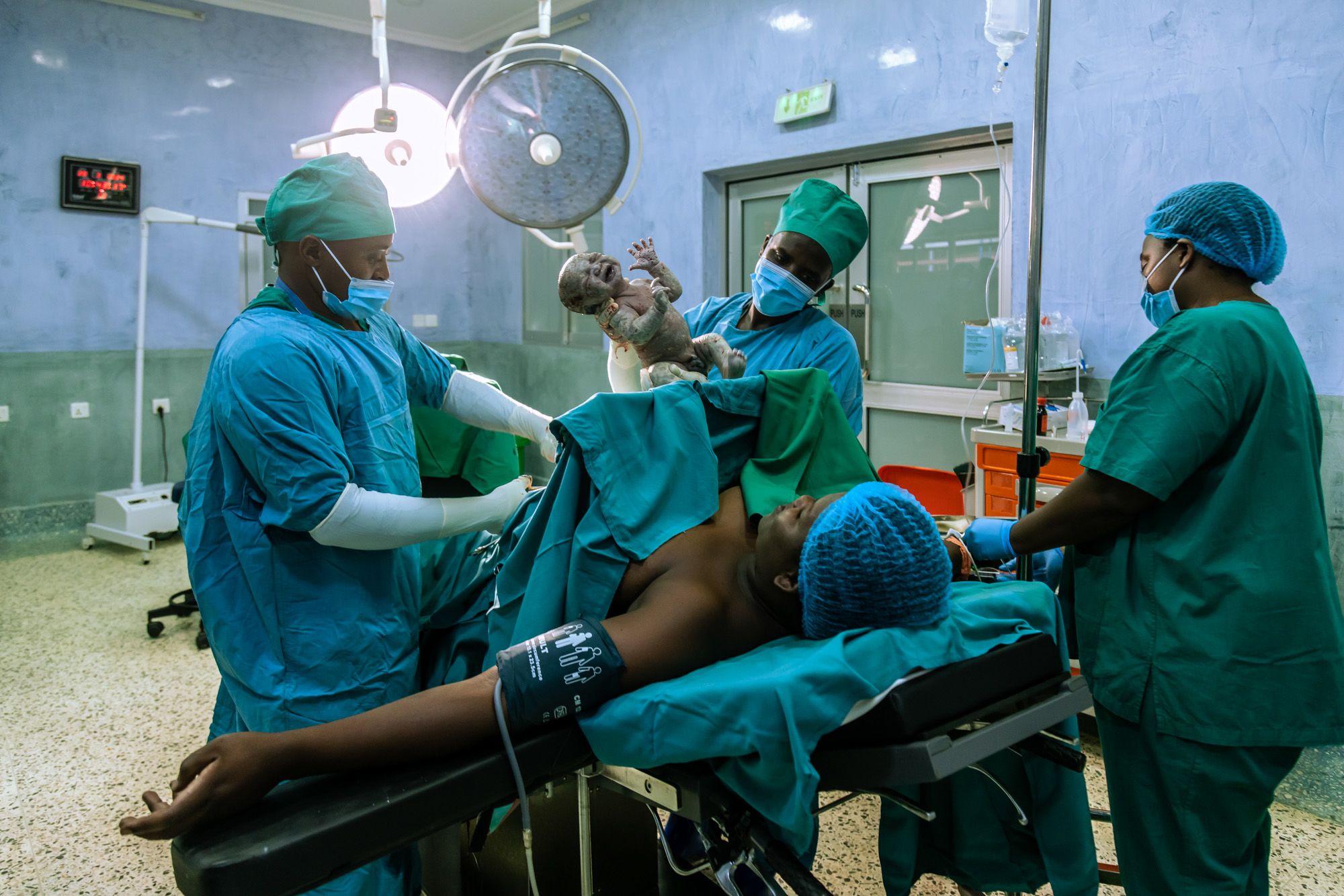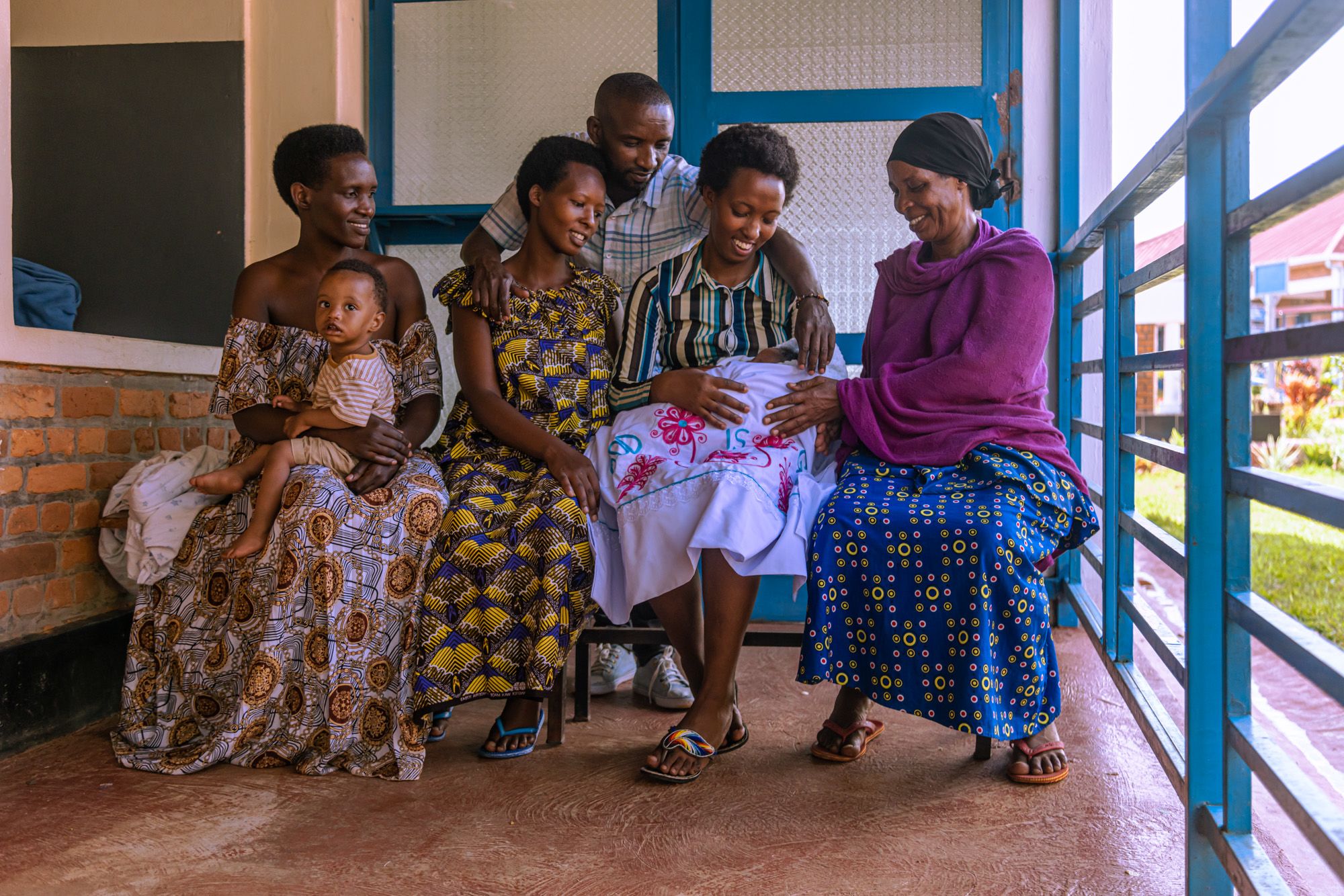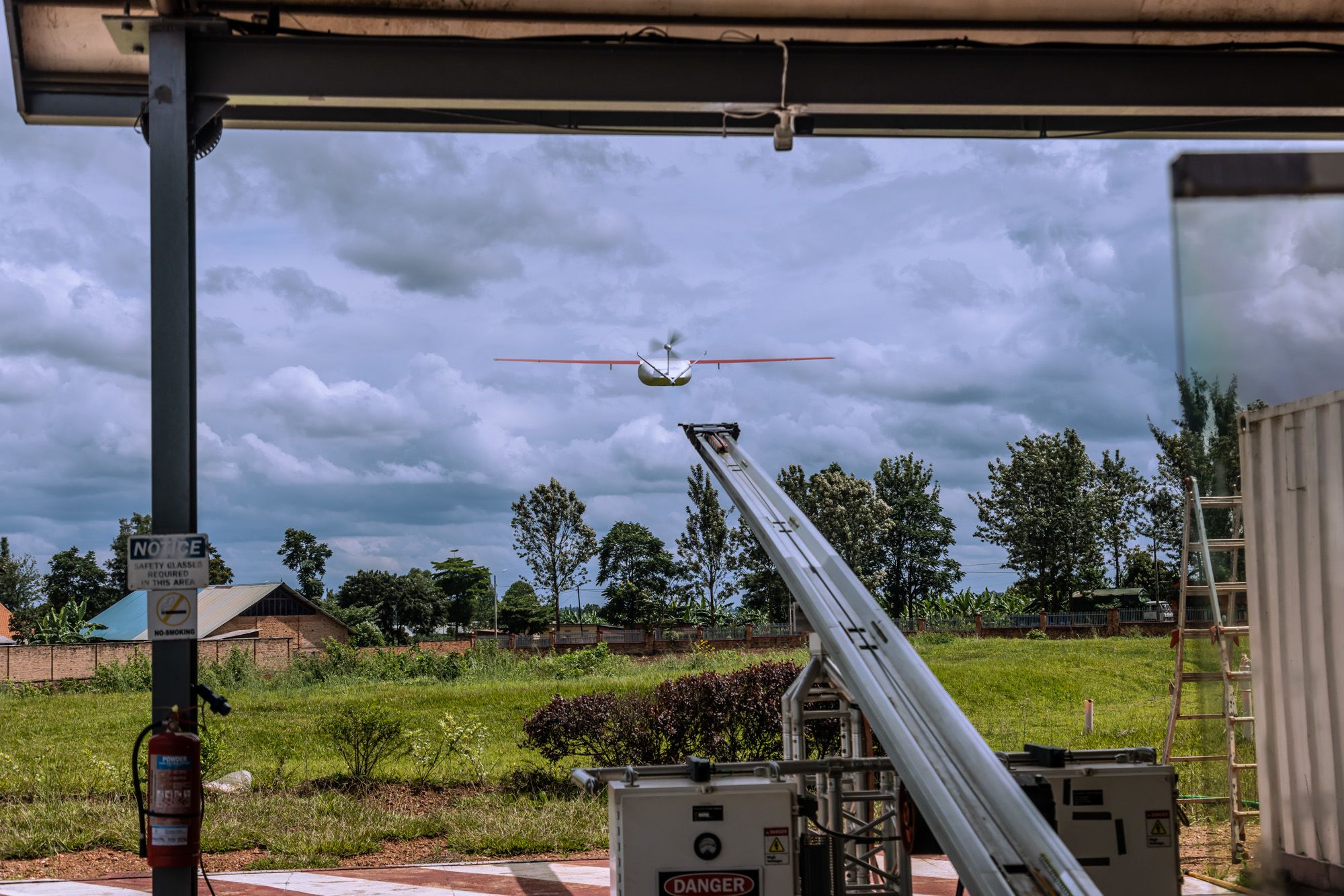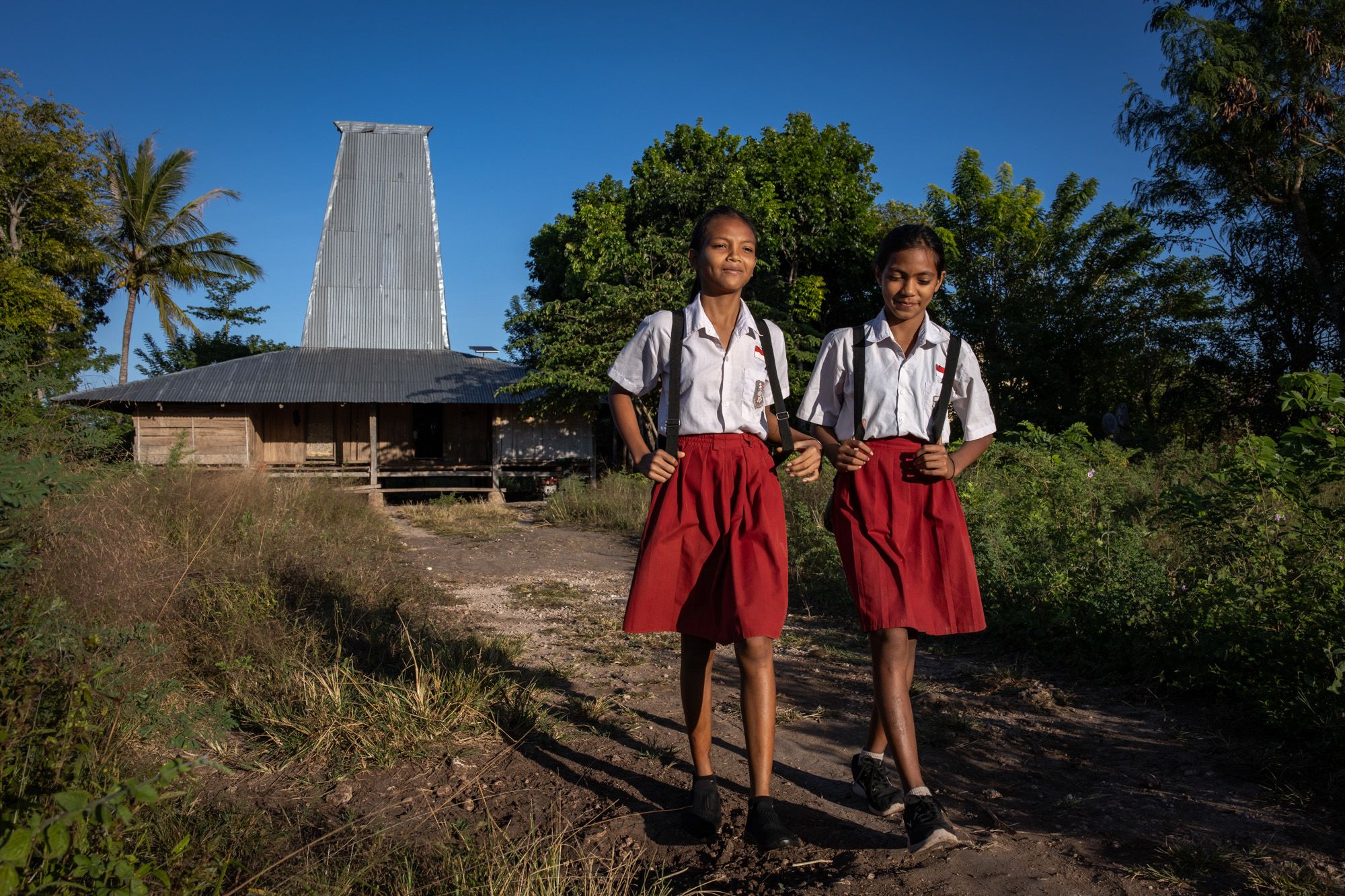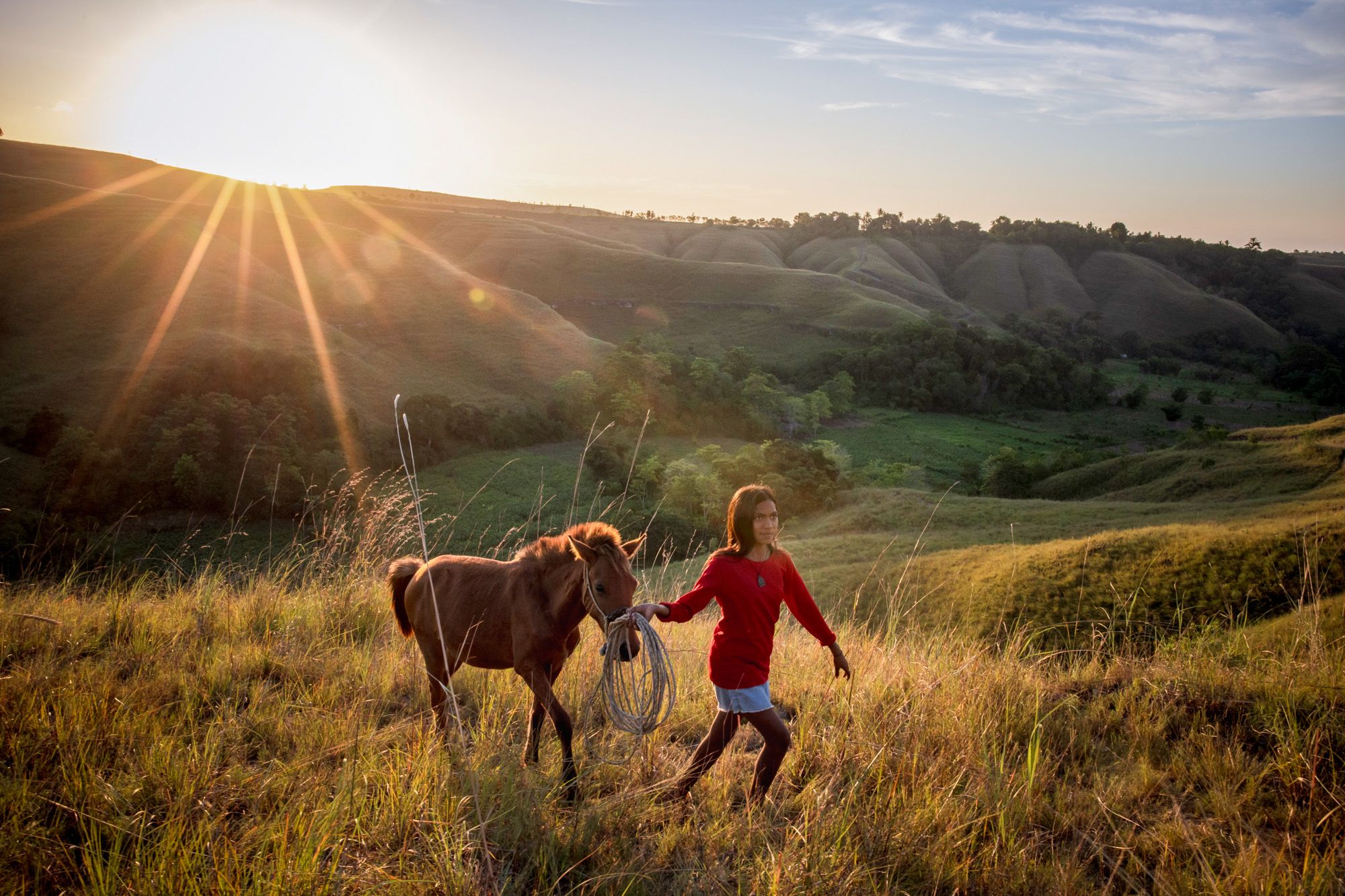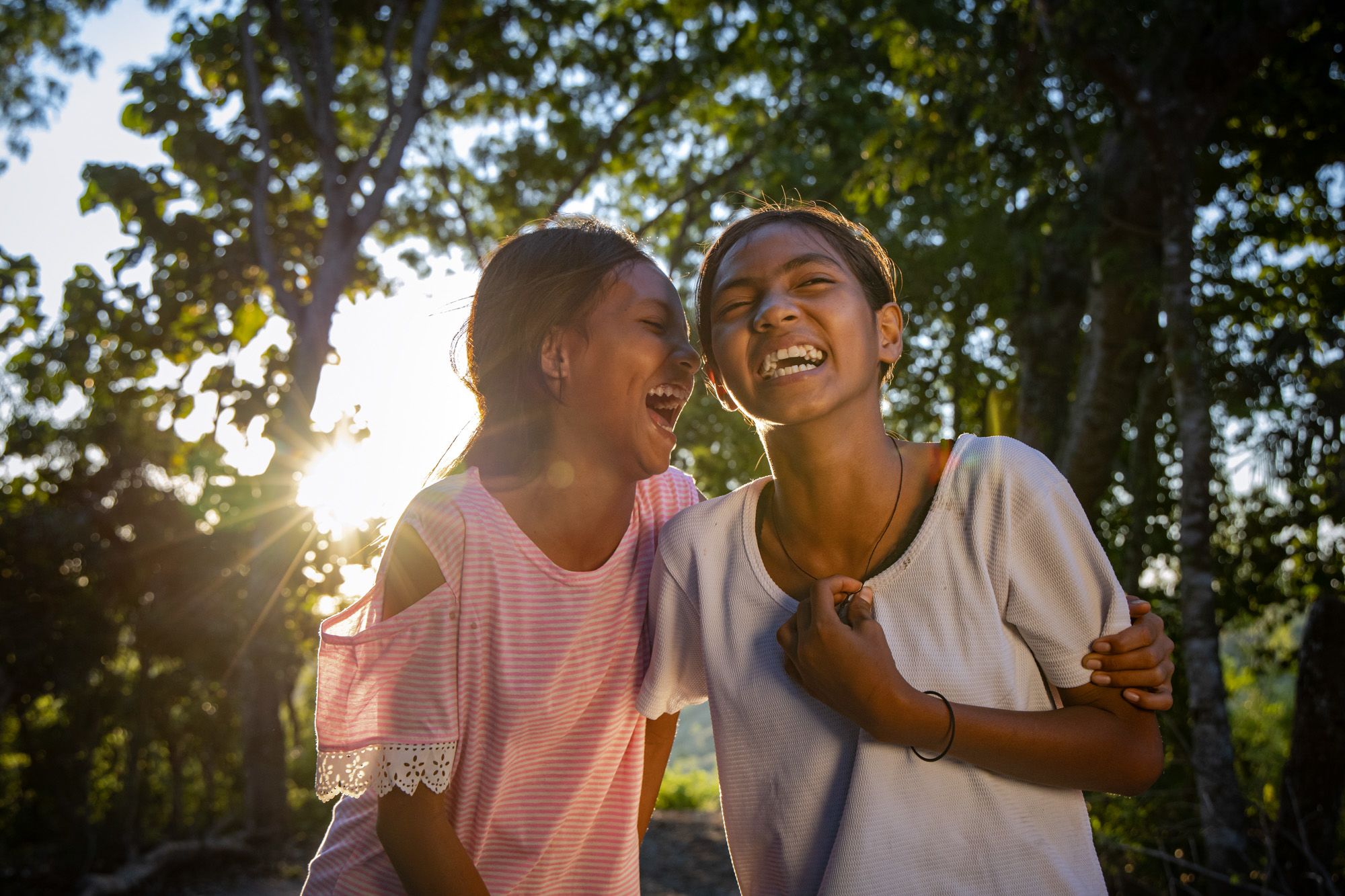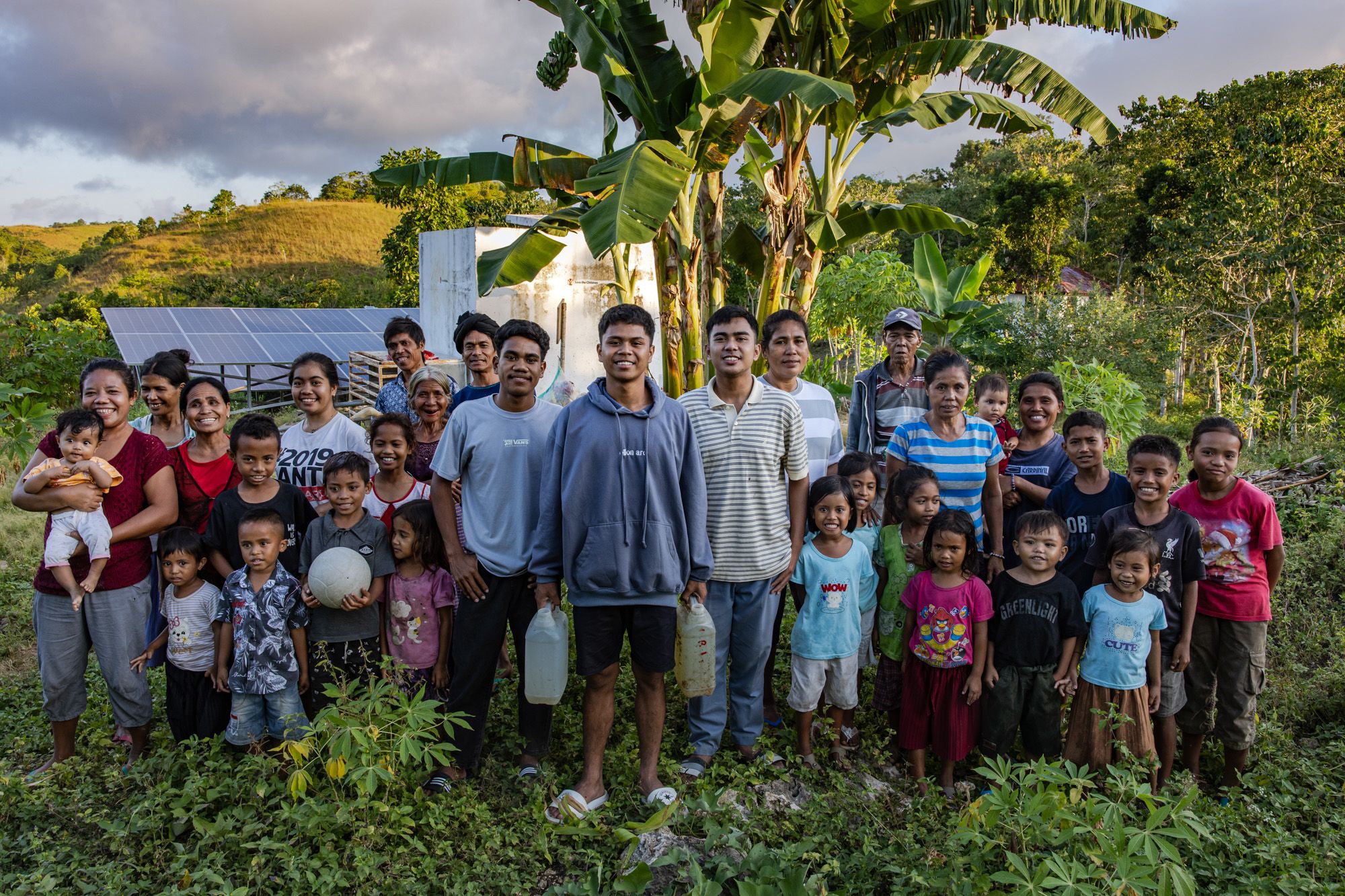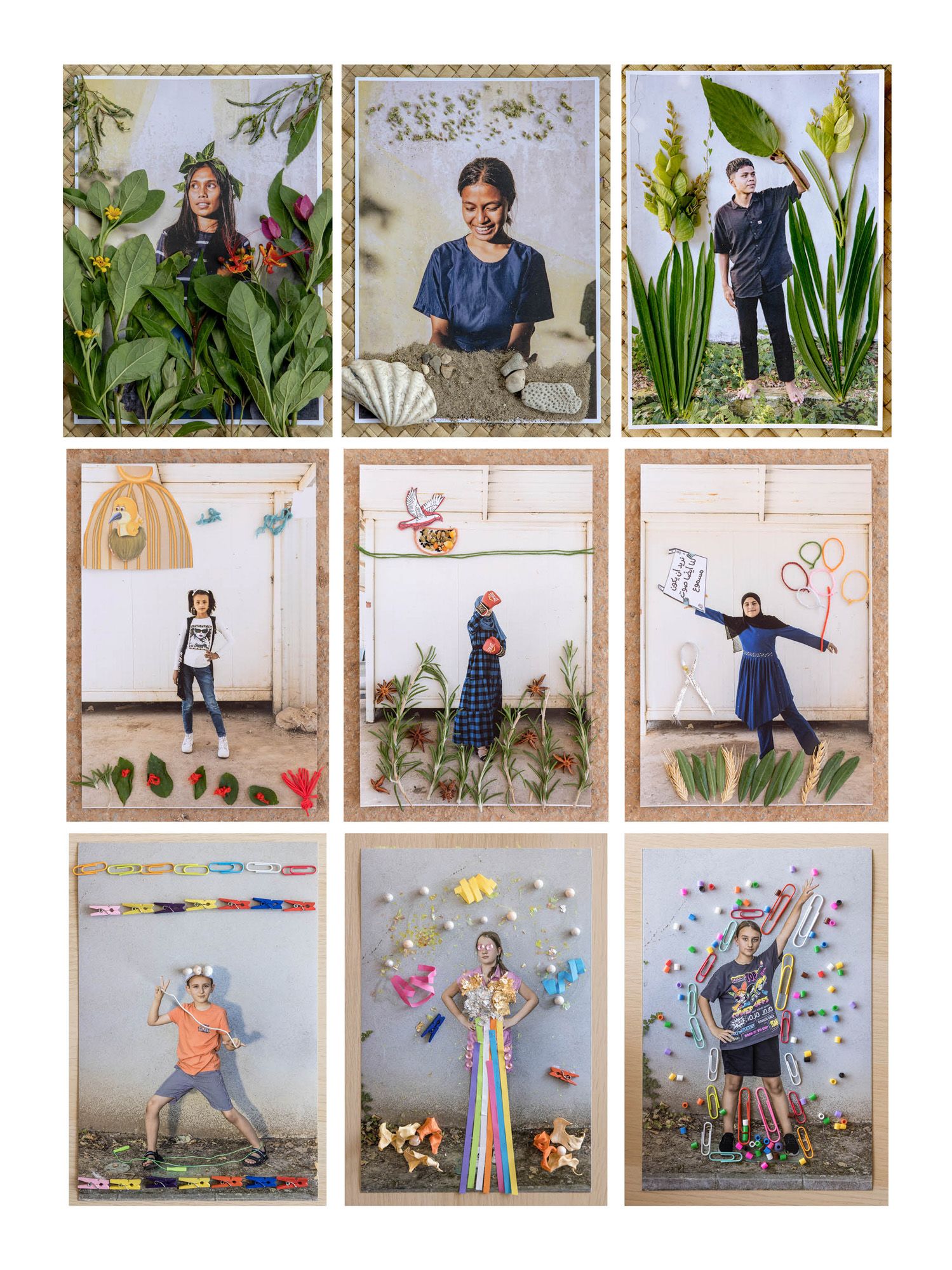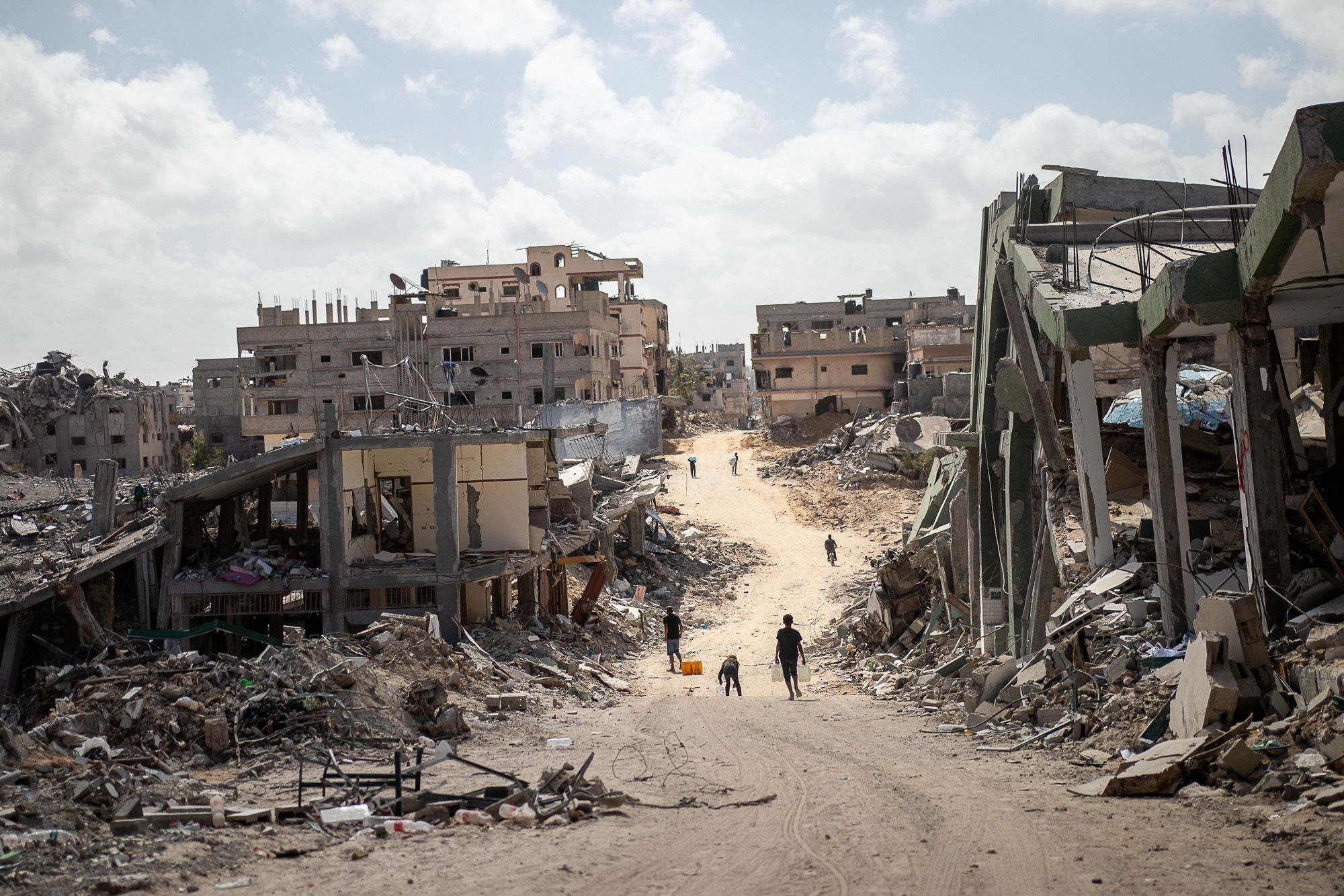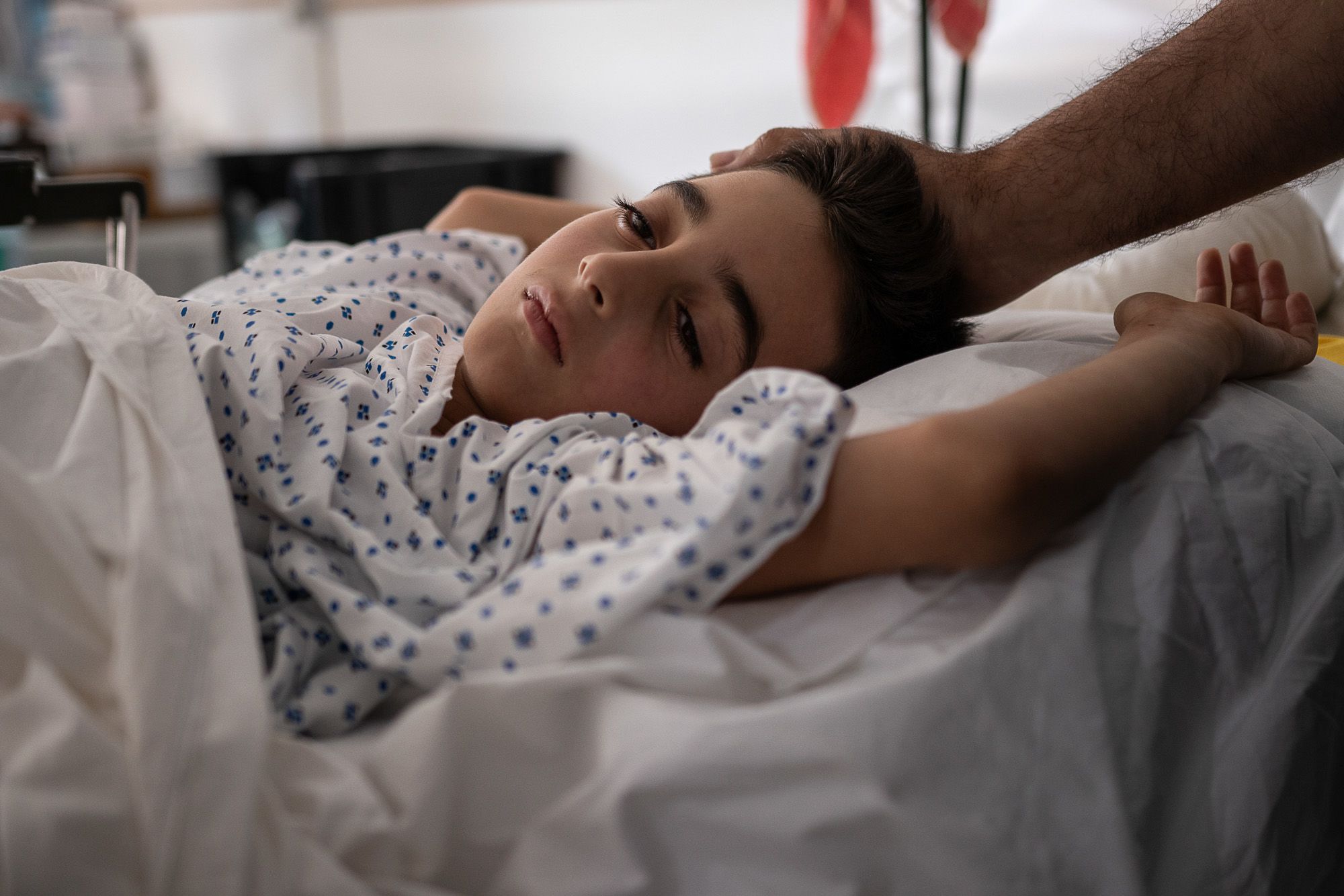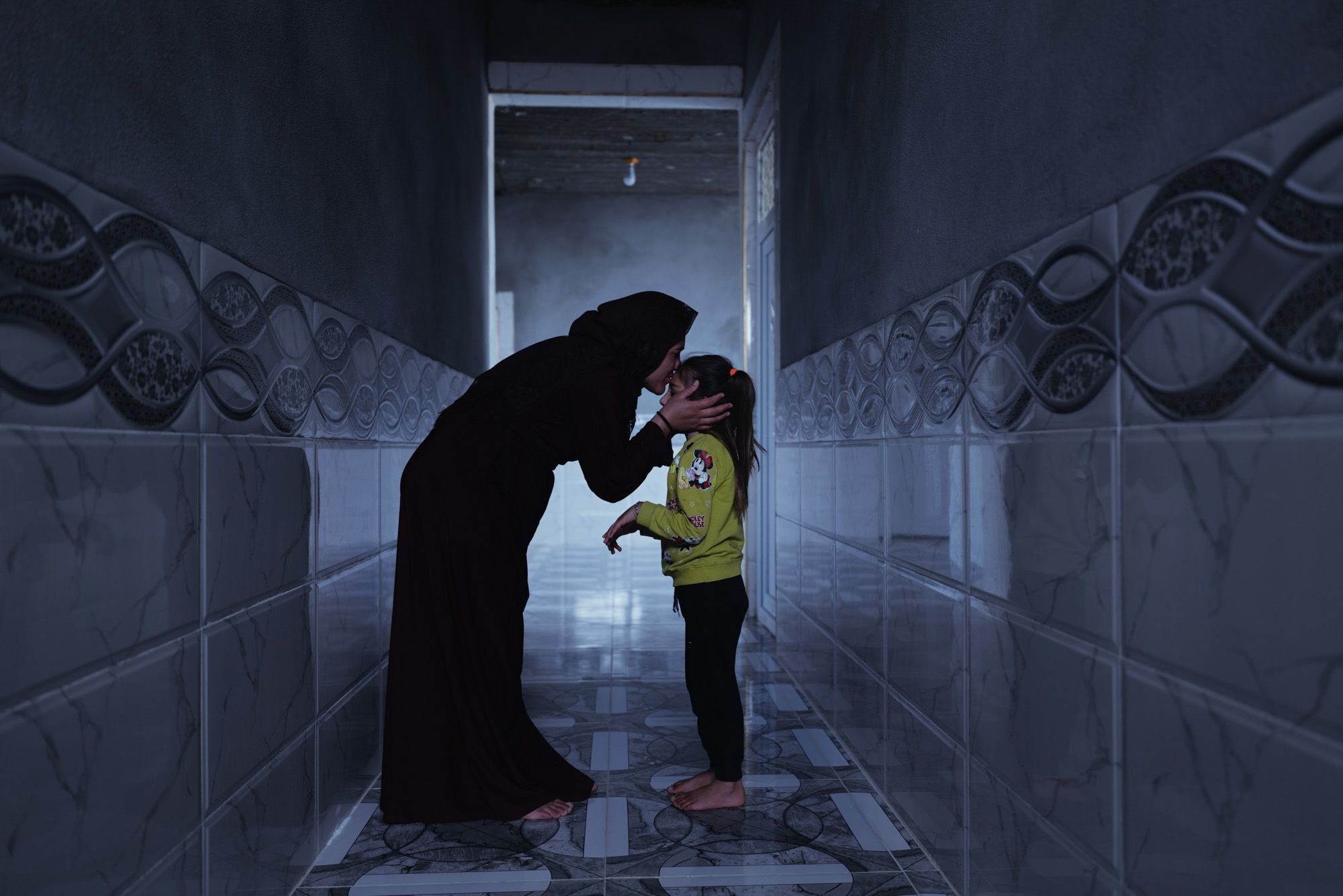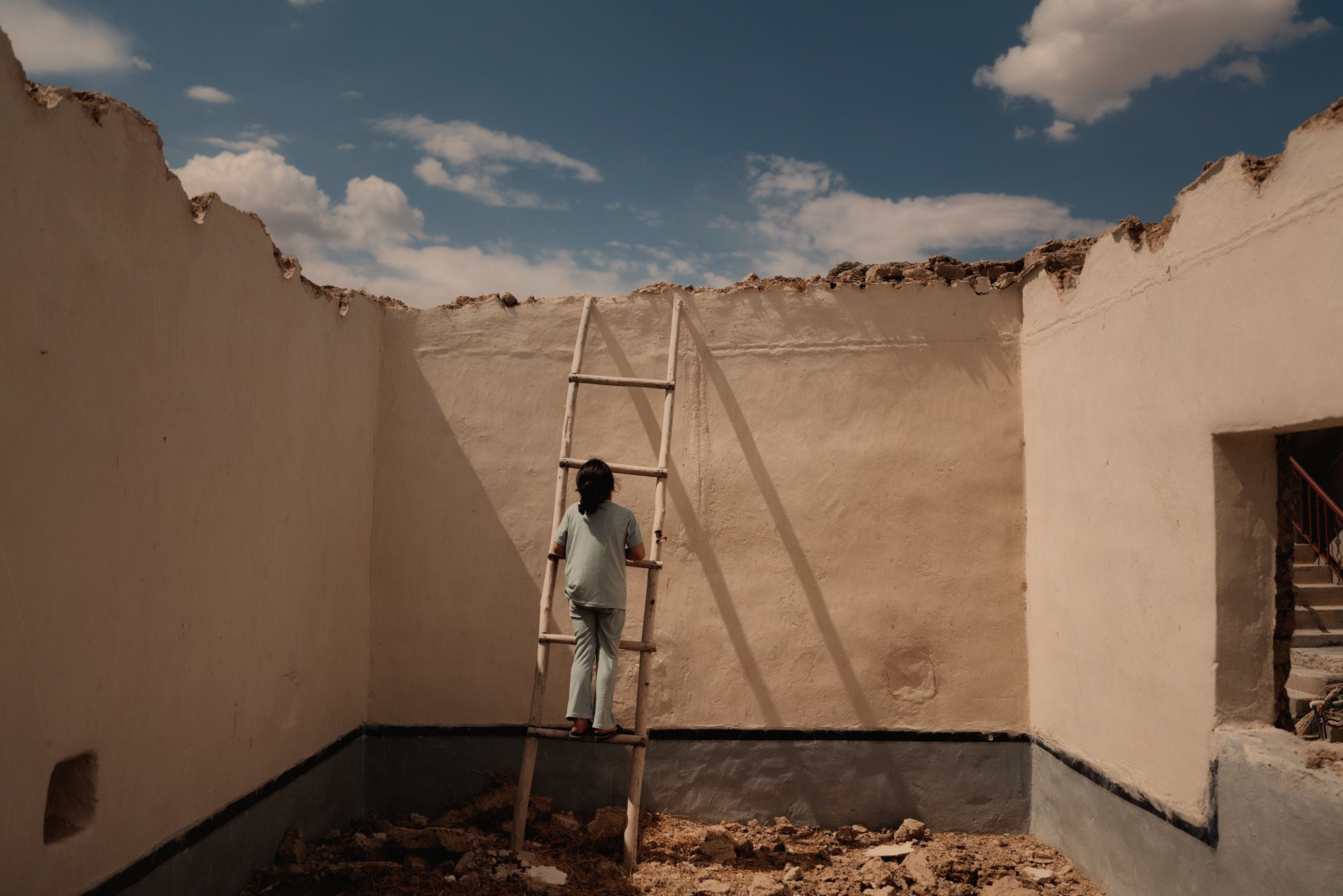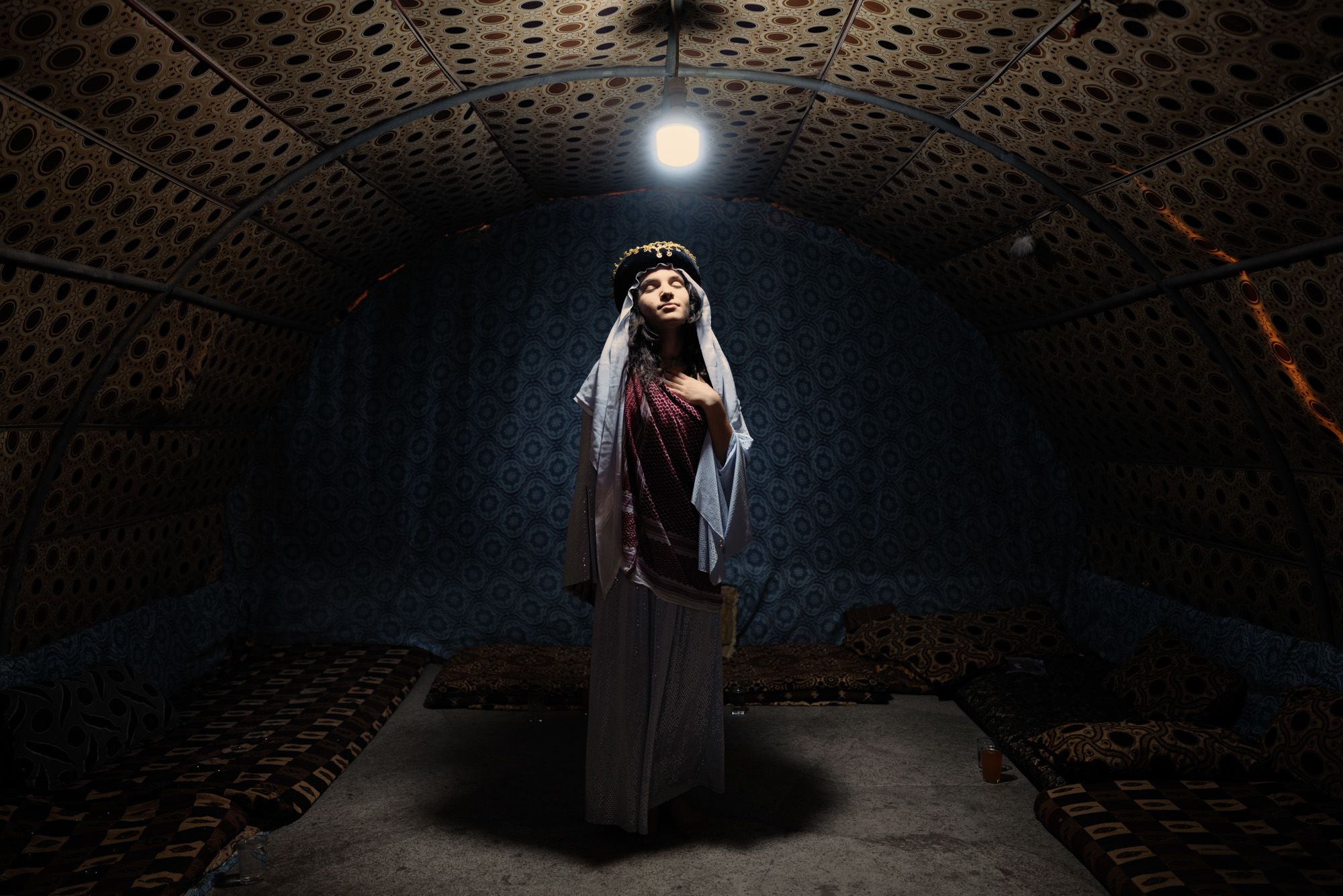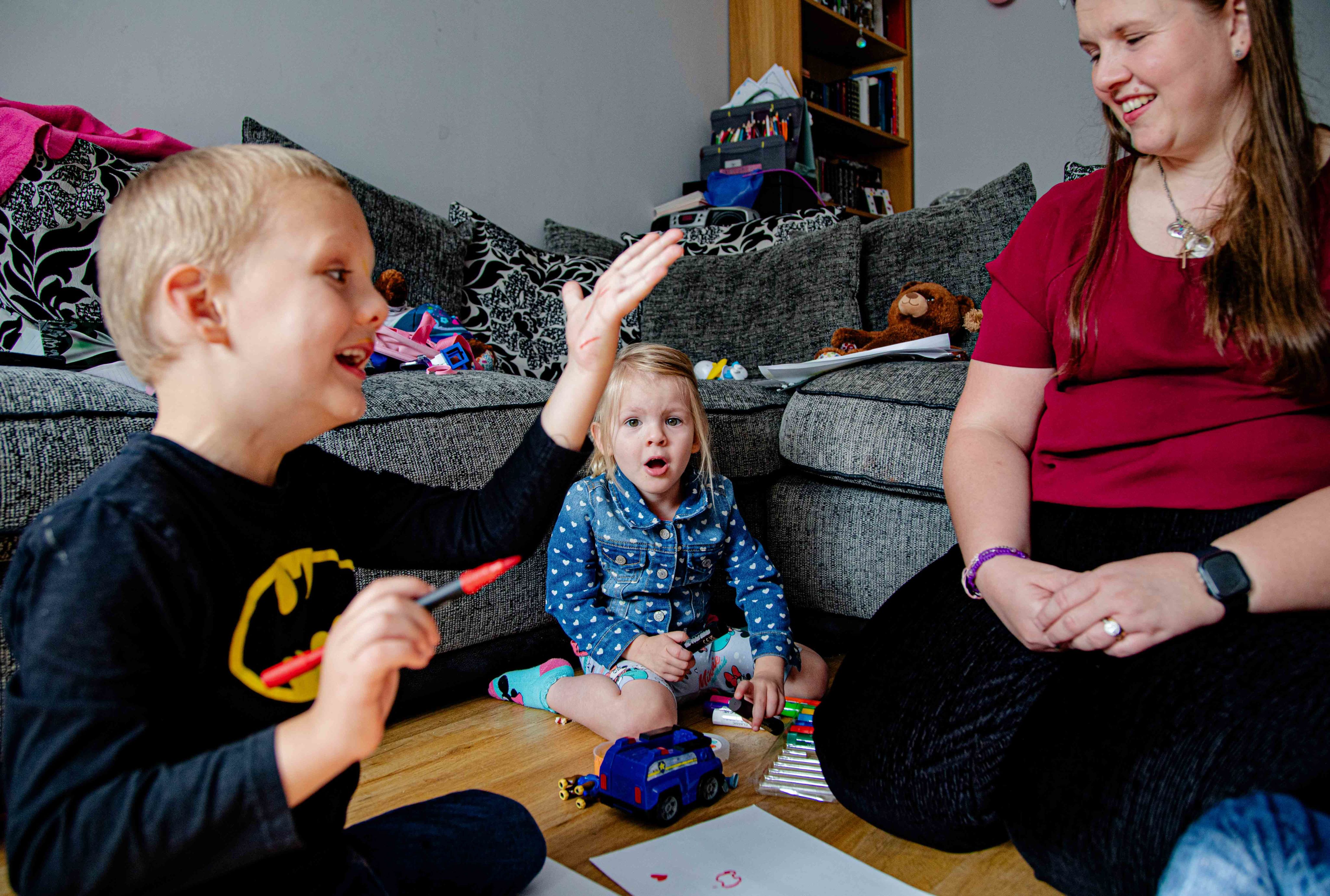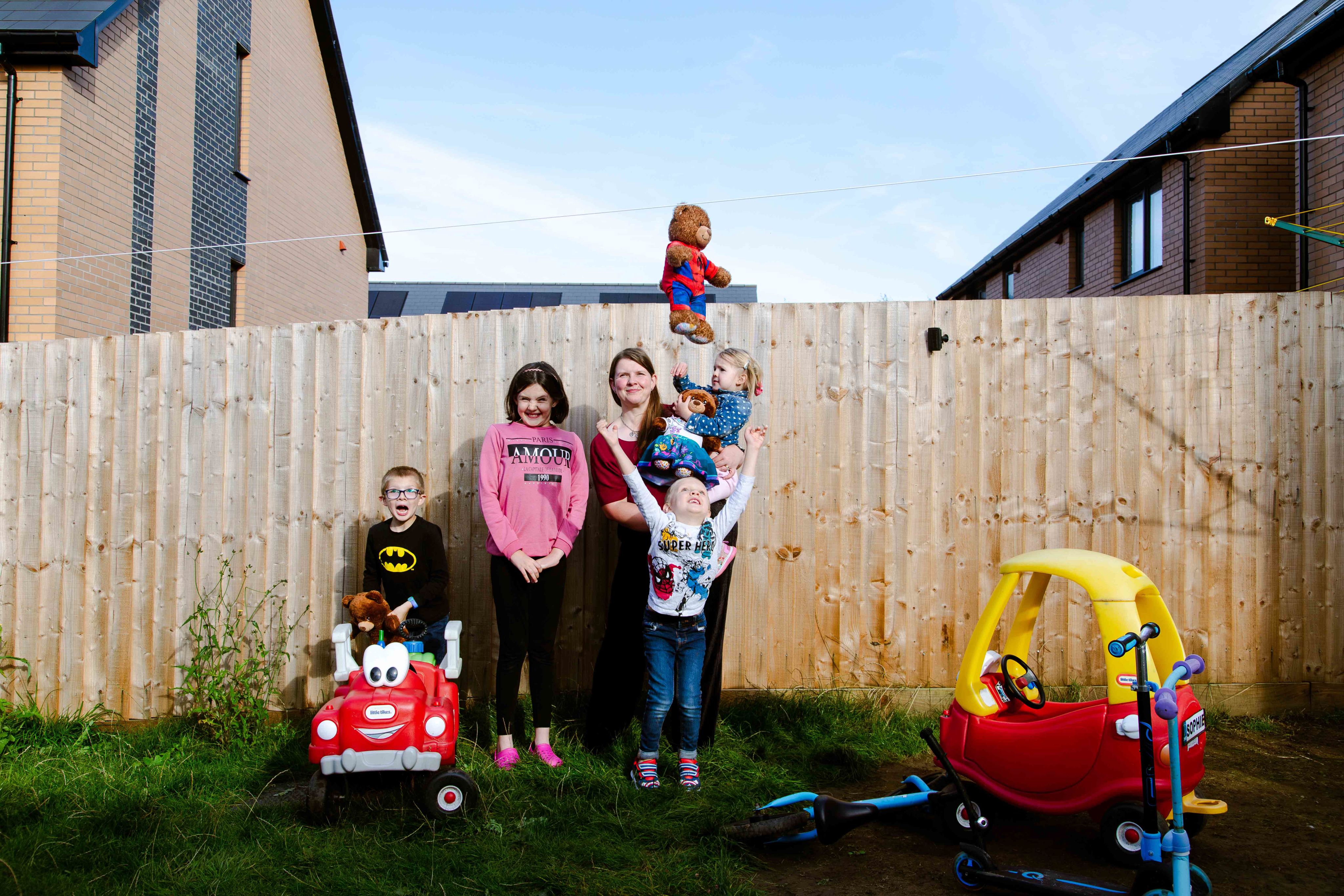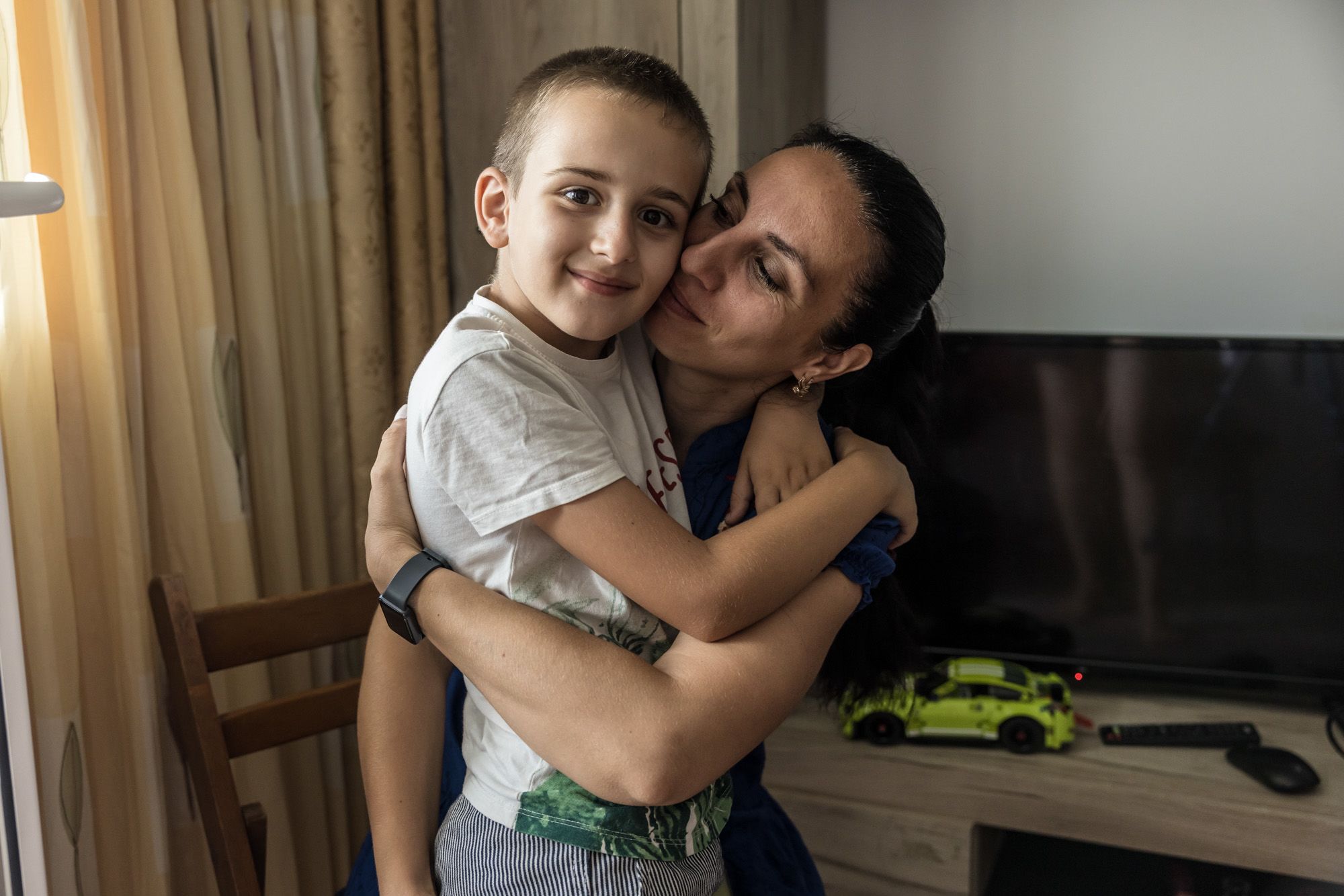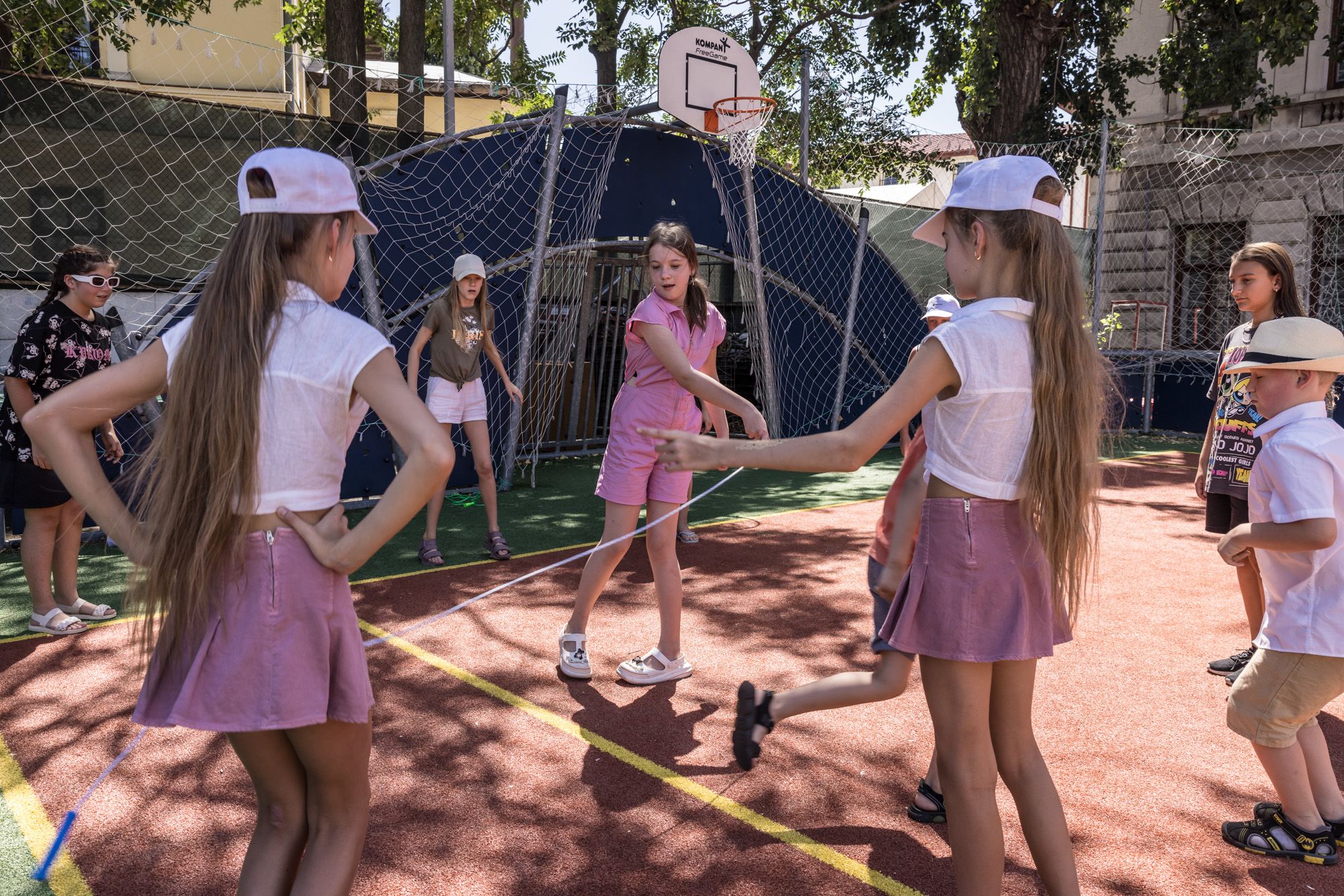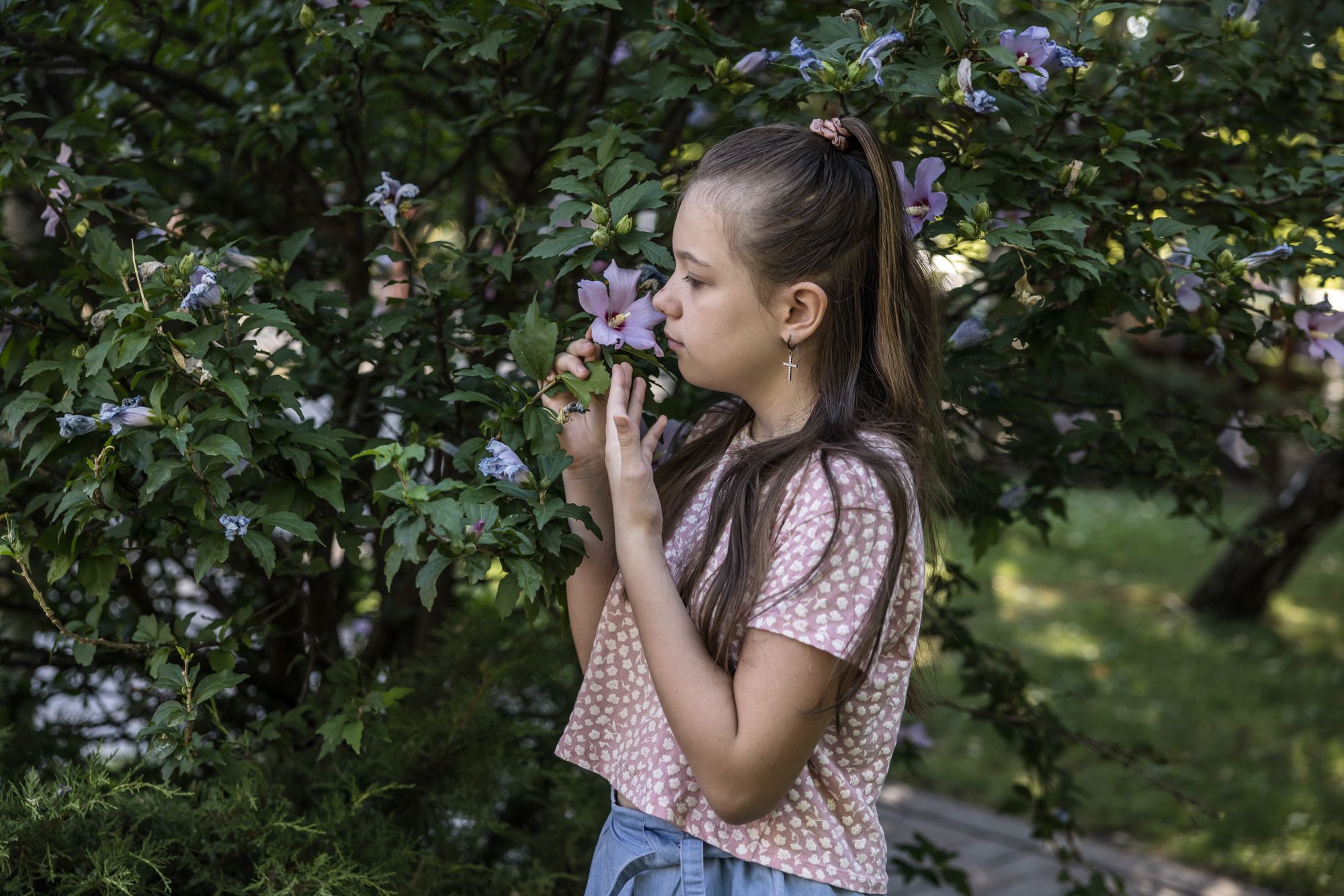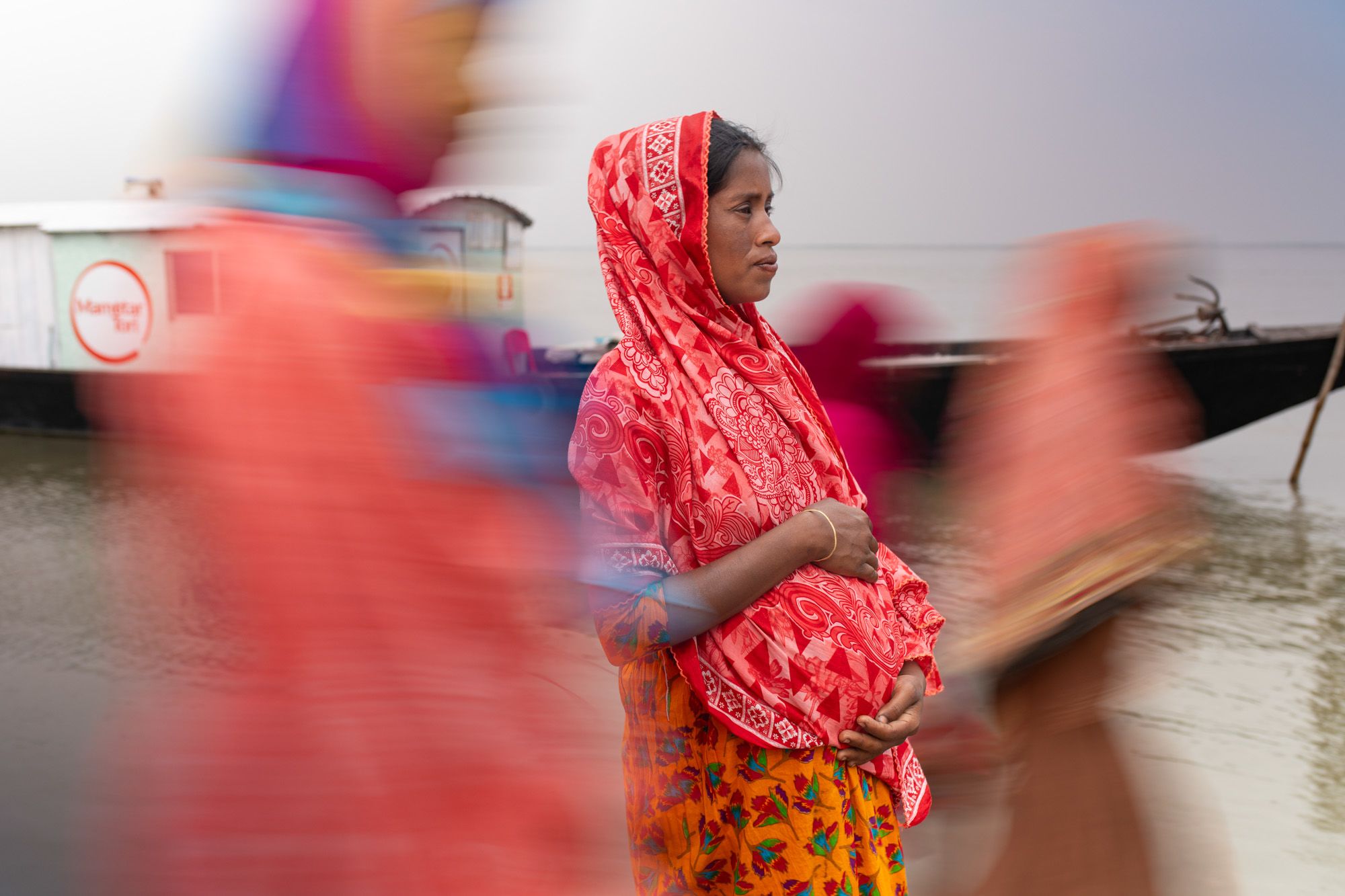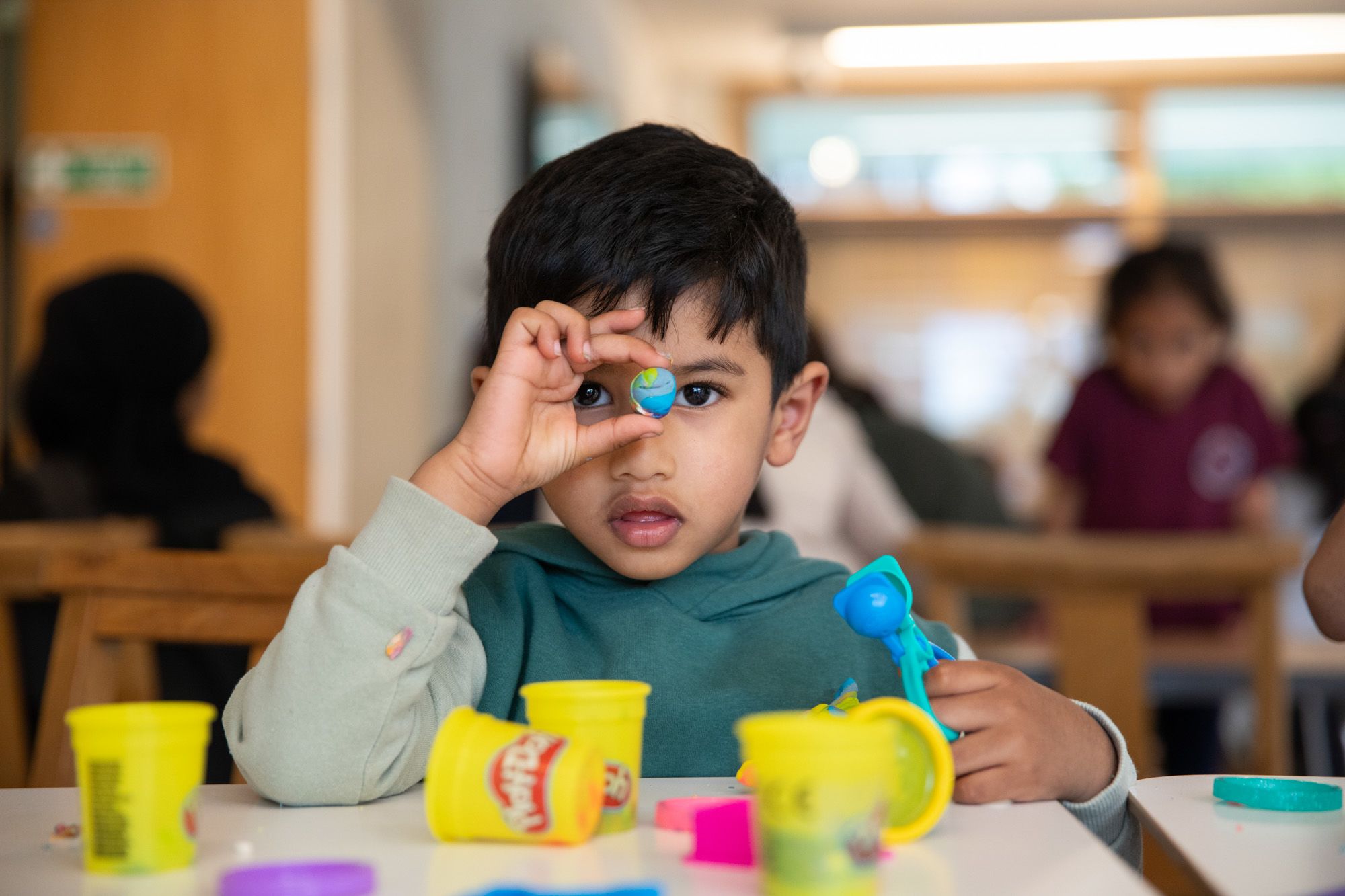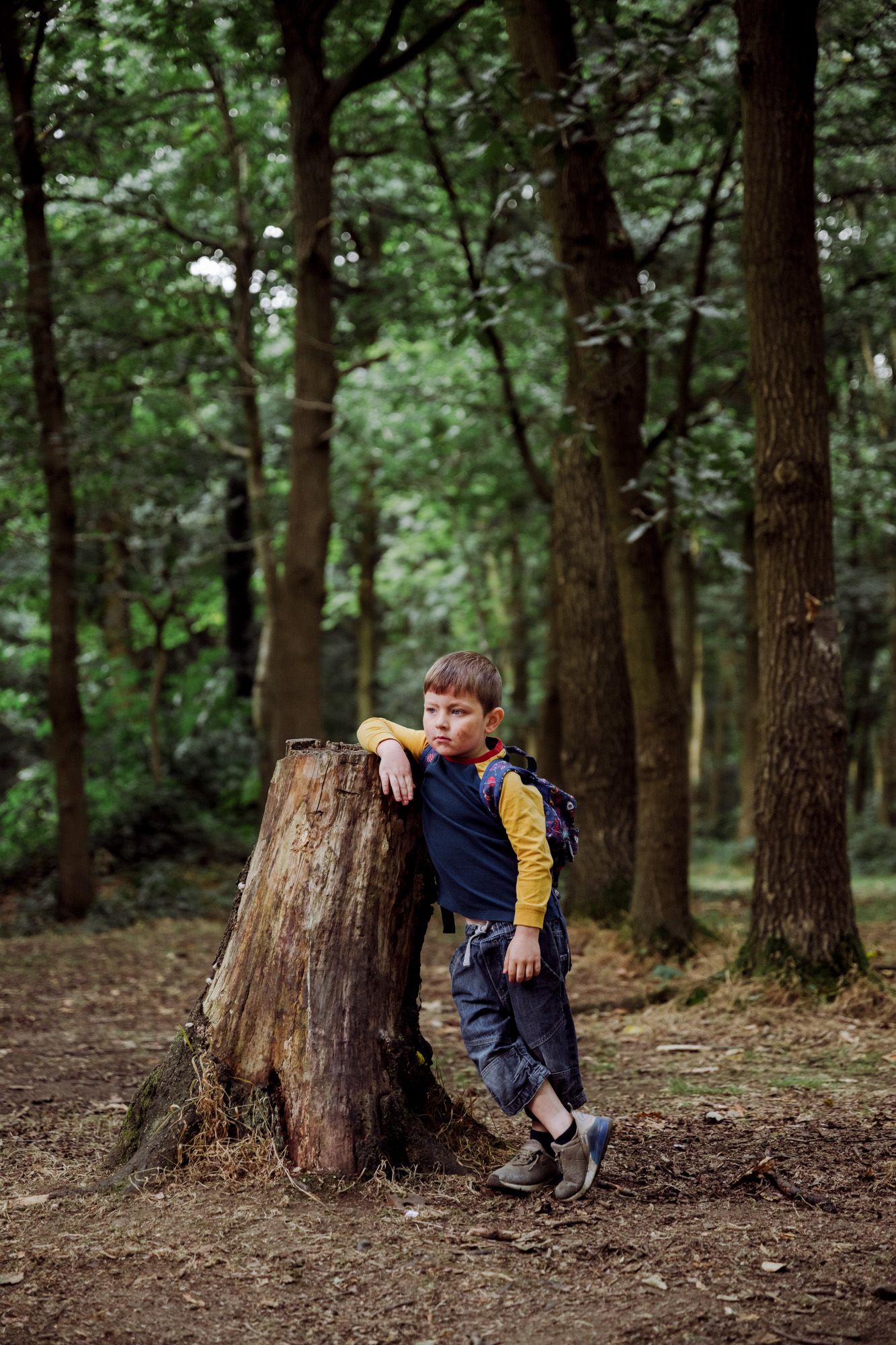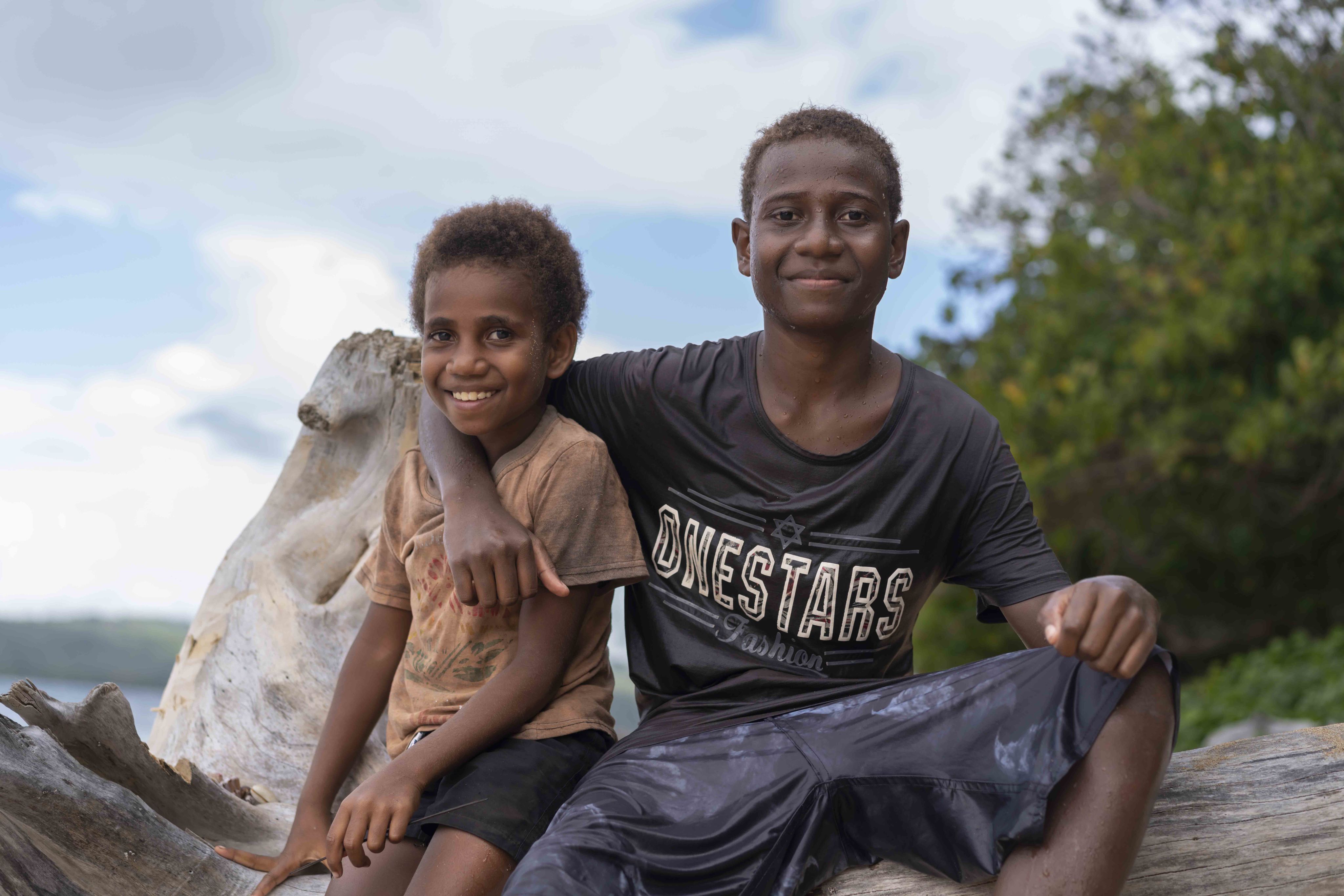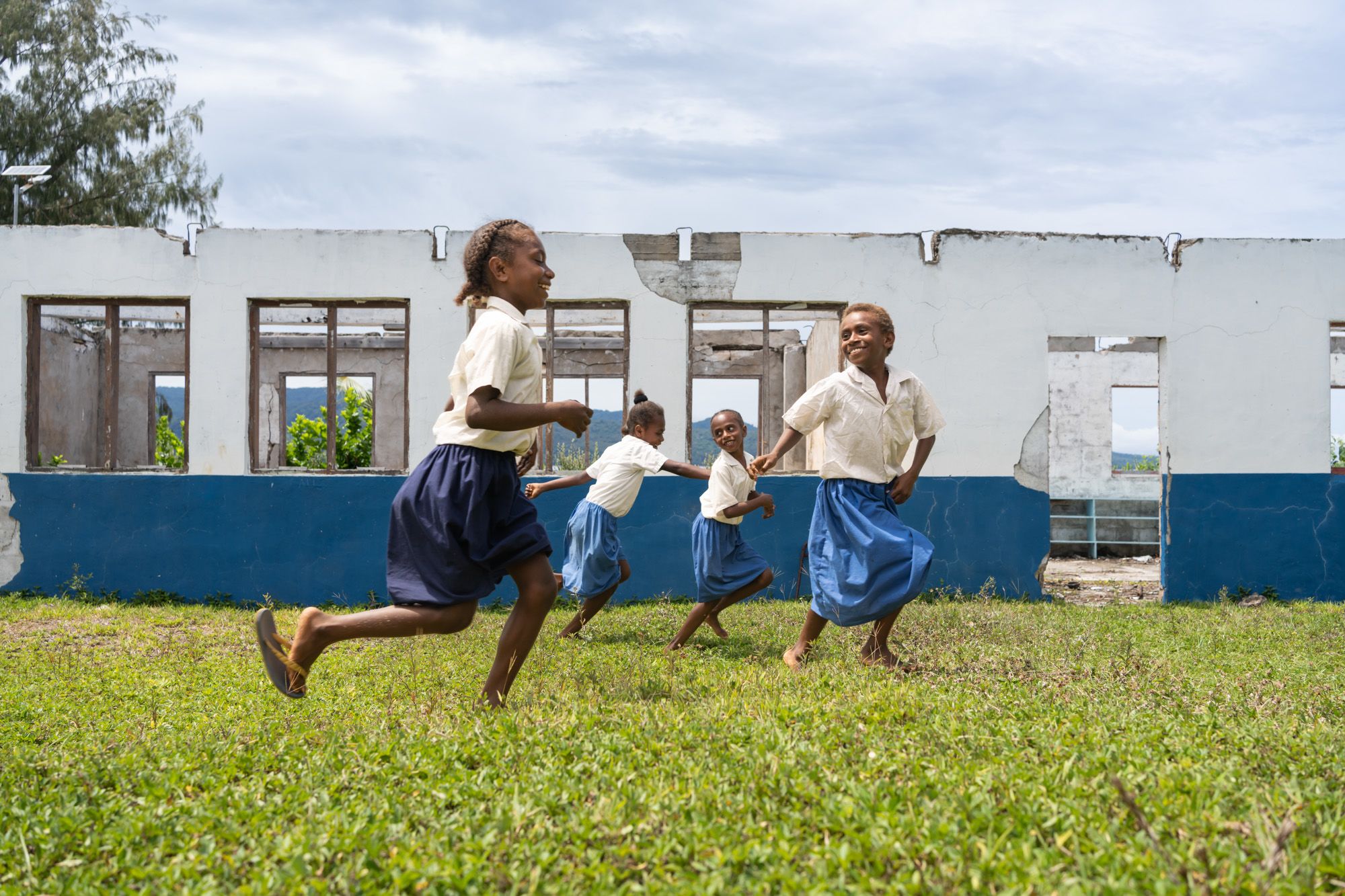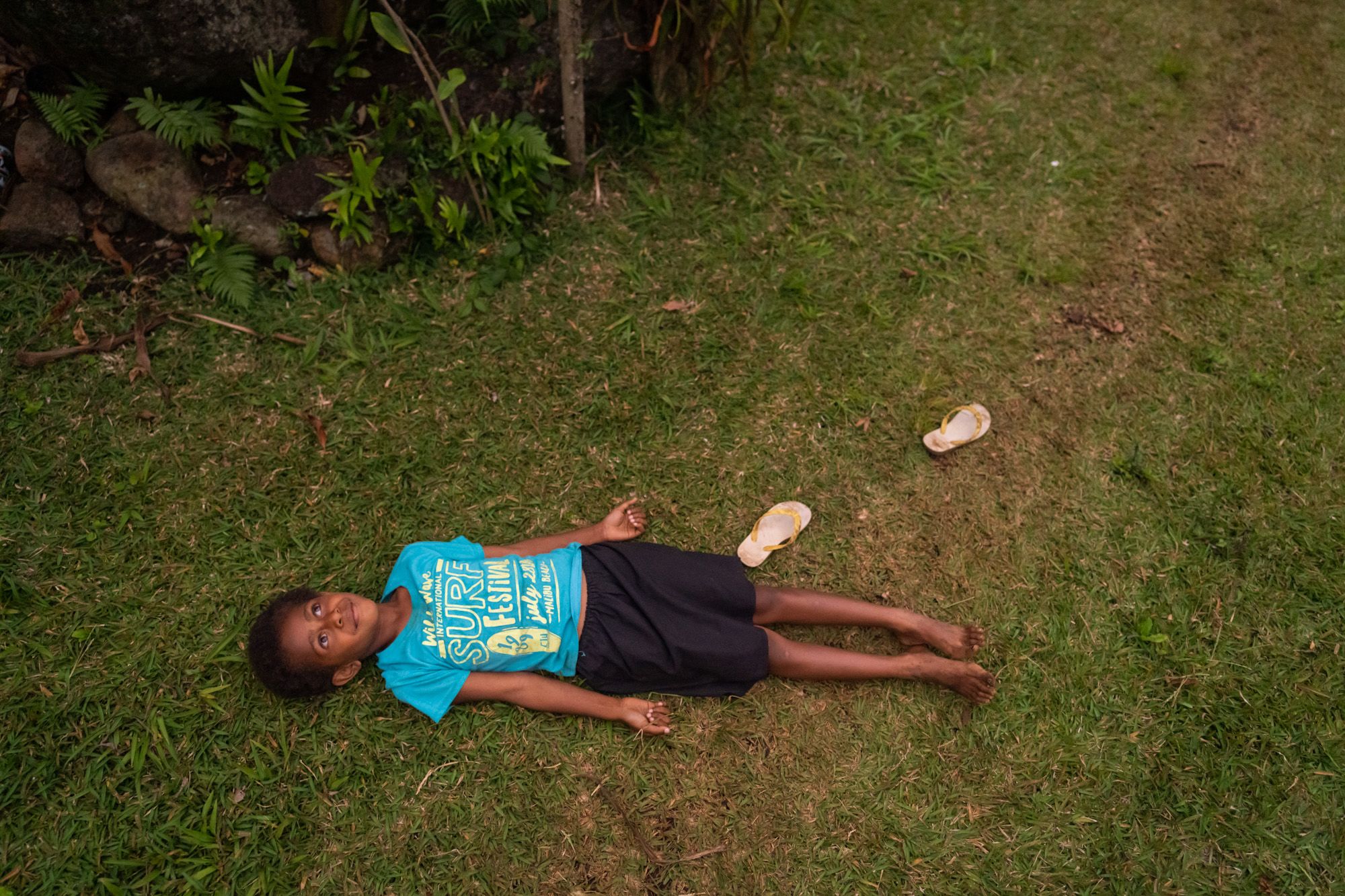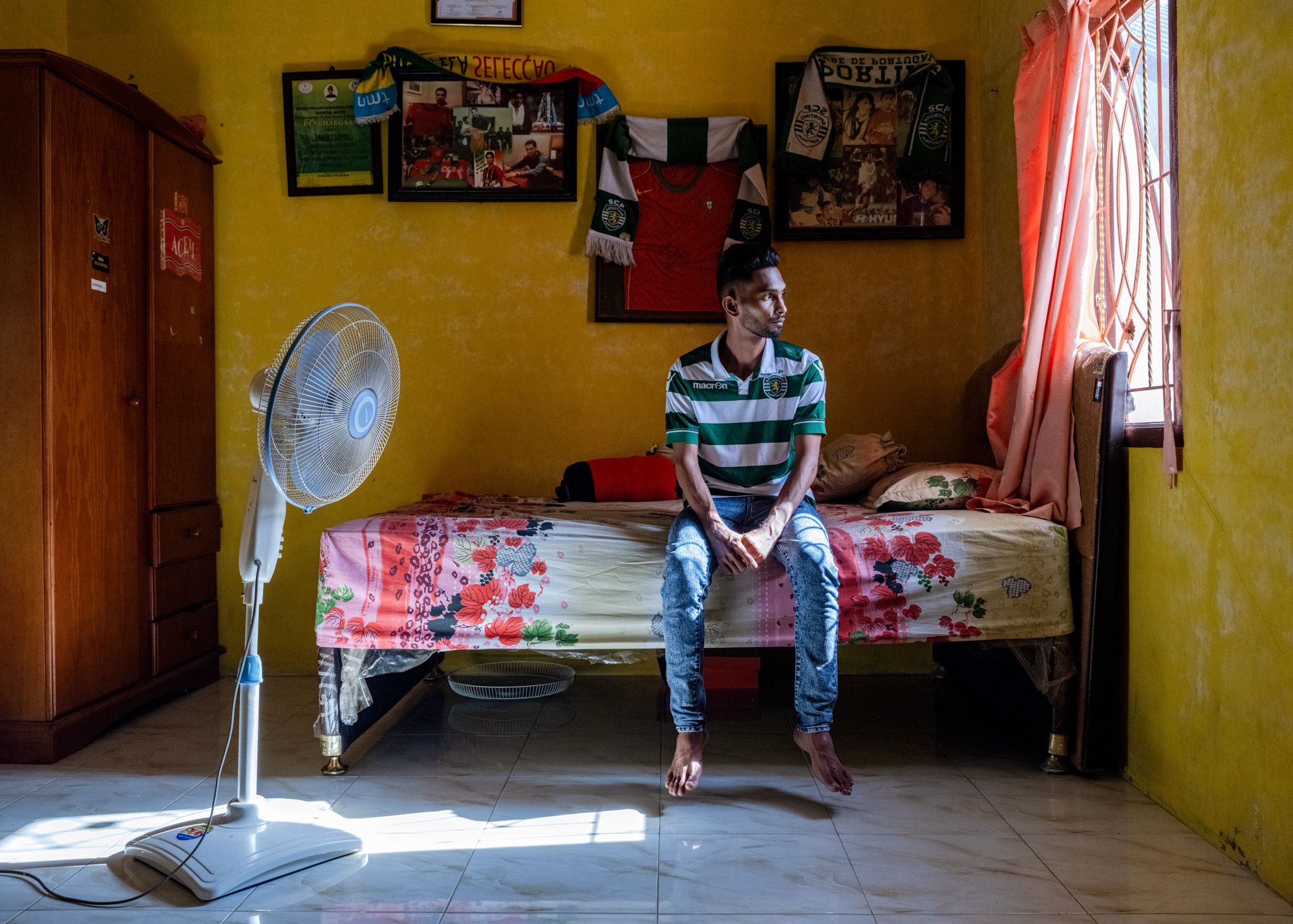2024: The Year in Pictures
And the stories behind them
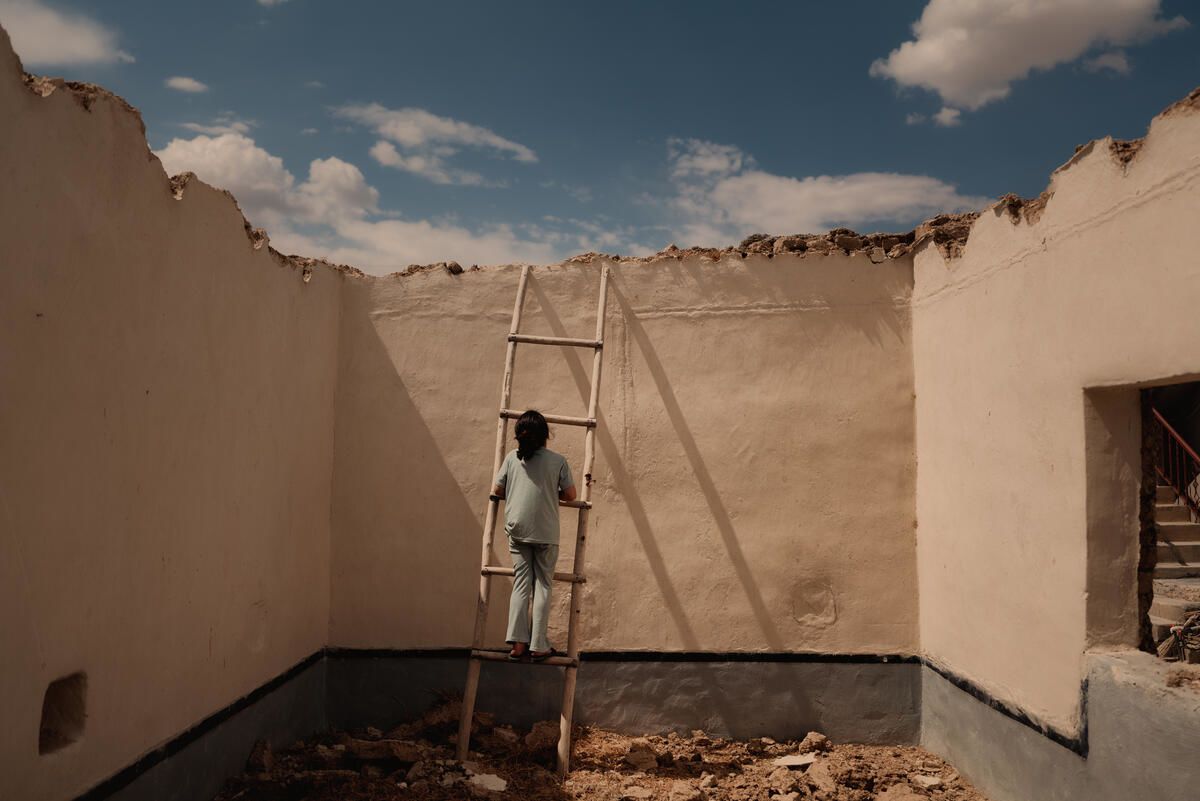
If we’re lucky, our childhood home is a safe place from which we dream of adventure, and set out for school with full bellies and carefree plans. For many of the children in these photographs, and the 117 million around the world displaced this year, home is fragile if it exists at all. For some it’s a mythical place their parents talk of, a place razed to the ground by war or changed by the climate crisis.
These photographs explore recovery and resilience. Loved-ones and strangers help each other out, pool knowledge and skills to rebuild stronger after a storm; to provide care in spite of their pain. And moments start to happen that make a place feel like home: An eight-year-old boy helps his mum with the chores. A trusted midwife comforts a mum-to-be. Two friends walk to school together laughing. A boy, scarred by violence, starts to dream of his future.
Moments like this can pass us by. But every childhood should be full of them and these photos reminds us why.
RWANDA
Doctor Yassin holds up Beata’s* baby, Beni*, following a successful caesarean section at a medical facility run by Save the Children in Mahama Refugee Camp, Rwanda. Photographer: Yagazie Emezi. @yagazieemezi
Doctor Yassin holds up Beata’s* baby, Beni*, following a successful caesarean section at a medical facility run by Save the Children in Mahama Refugee Camp, Rwanda. Photographer: Yagazie Emezi. @yagazieemezi
During the birth of her first child, Congolese refugee, Beata*, had complications and was referred to a hospital two hours away from the camp where she lives. Though her baby was born healthy, Beata’s experience was dangerous and stressful: “The road was so rough. The car was bouncing me all the way. I thought that I might deliver on the way.” Since then, Save the Children has made huge improvements to the Medicalised Health Centre in Mahama refugee camp, and Beata’s second child was delivered by a skilled team just a walk away from her home.
Photographer Yagazie Emezi:
"In this photo Doctor Yassin is delivering Beata’s baby through caesarean section and in this moment, he has just pulled Beni out and is showing him to Beata. I remember very well this part where she kept saying, “mon chéri, mon chéri” and she was so happy and couldn’t take her eyes off him.
"It’s important to show the medical techniques that are available to patients. But more than anything, the work that is being done by African doctors.
"Unfortunately, there is still so much negative stereotyping when it comes to what happens on the continent. Other images that are put out there are usually showing traditional midwifery, so it’s important to show this level of technique and technology that is actually quite commonplace.
"The whole scene of being able to watch a child being brought into this world is a reminder of the little things that draw us together."
A family portrait of Claire*, her newborn baby, Aimé*, husband, sister and mother outside the maternity ward of a medical facility run by Save the Children in Mahama Refugee Camp, Rwanda. Photographer: Yagazie Emezi. @yagazieemezi
A family portrait of Claire*, her newborn baby, Aimé*, husband, sister and mother outside the maternity ward of a medical facility run by Save the Children in Mahama Refugee Camp, Rwanda. Photographer: Yagazie Emezi. @yagazieemezi
Claire* is a Burundian woman who was referred to Save the Children’s maternal health centre when she had complications. Dr Yassin operated as soon as possible and Claire gave birth to a healthy baby boy. This photo was taken after the rest day, when Claire’s husband and family came to welcome the baby and accompany them both home.
Photographer Yagazie Emezi:
"I just thought it was very sweet to see how hands-on everyone was, especially her sister, because Claire was obviously still in recovery from the c-section, so she couldn’t carry the child herself. It was very nice to see how excited her sister was, how present her husband was, and her mum, and just that aspect of community, to have one of your friends show up to support you.
"It challenged my expectations of what a healthcare centre could look like in a refugee camp. It was pristine. I’ve seen private hospitals at home [in Nigeria] that can’t even compare with the level of care that was at the health centre."
A drone packed with medical supplies and blood takes off at Zipline in Kayonza, Rwanda. Photographer: Yagazie Emezi. @yagazieemezi
A drone packed with medical supplies and blood takes off at Zipline in Kayonza, Rwanda. Photographer: Yagazie Emezi. @yagazieemezi
A partnership between innovative US drone company, Zipline, and Rwandan Ministry of Health, means Save the Children can fund the speedy delivery of drugs and blood to the medical centre at Mahama refugee camp.
A medic or lab technician places an order by text or phone call and within five minutes, the order is in the air. When the drone is two minutes away, the team gets a warning text so they can clear the area and collect the package. Each drone can carry up to 1.6kg of medical supplies – that’s three 500ml bags of lifesaving blood – and in an emergency, it arrives within half an hour.
Photographer Yagazie Emezi:
"I’d never seen a drone deliver before. We went over to the flight centre and we could see the whole process from beginning to end – where they stored the goods, how they assemble the drones, and how quickly they work. For me it was important to get that moment of launch that also captures the body of the drone itself."
INDONESIA
In Indonesia this year, life at home got harder for many children. Two and a half million children were expected to face water scarcity, food insecurity, and related challenges like missing school.
Twelve-year-old Atika is pictured here walking to school with her cousin Dwi. In her community, children were missing school – some to help out at home or search for food or water; others because their parents couldn’t afford to eat, let alone cover the costs of uniform and equipment. But school attendance has been boosted thanks to new access to water and cash assistance for school costs.
Photographer Ulet Ifansasti:
“Atika and Dwi are cousins. They are very close as cousins but also as friends. They are very connected, they’re the same age, and want to share everything together. When we arrived in their village it was around 6am, and they were preparing for school. It was a very nice light and in the background is Atika’s house, a traditional house of the Sumba people with tall, pitched roofs that tower up to the sky.”
The signs of climate change are in the landscape all around Atika’s home. “The trees are too brown…” she says: “The fields are burned.” Her community’s crops failed last year – decimated by drought. Save the Children is delivering a programme of eco-friendly agricultural training and educational sessions at schools – shaped by community expertise. In all, 350,000 people across Indonesia, including 122,500 children like Atika, will have the chance to prepare for climate change – and see nature as a source of opportunity and joy again.
Photographer Ulet Ifansasti:
“This photo was taken in East Sumba. It’s such a beautiful island. There are horses everywhere, savanna; lots of beauty. In this image, Atika is walking with her neighbour’s horse, climbing up the valley. We were photographing the daily life of Atika and her family in her community. It was taken around 5pm in golden hour, the lighting was very nice. Horses are a very important part of Sumbanese culture. The horse is part of their family, and their life, and is so important to them.”
The Stimulant Institute and Save the Children introduced a solar powered water system that pumps clean water to Atika’s community. “We don't worry anymore,” says Atika’s father, Titus: “And children no longer need to go to the springs.”
Photographer Ulet Ifansasti:
“Atika and Dwi had been collecting water with jerry cans from a new solar-powered water system Save the Children had built in their community. Drought and water shortages are common in East Sumba, particularly during the dry season. They stopped for this photograph whilst walking back home. It was the golden hour, and the sun was setting behind them, so we decided to shoot into the light. I used a reflector to bounce the light on their face. We were talking about something and they just burst into laughter, it was a just very natural moment to capture.”
Sandi, Soleman, and Anjar, and families from Sandi’s village, in front of the water system they’ve designed in West Sumba, Indonesia. Photographer: Ulet Ifansasti: @uletifan
Sandi, Soleman, and Anjar, and families from Sandi’s village, in front of the water system they’ve designed in West Sumba, Indonesia. Photographer: Ulet Ifansasti: @uletifan
In 2023, in West Sumba, Indonesia, 18-year-old Sandi joined Save the Children’s i2Change programme, which supports communities to develop lifechanging innovative solutions. Sandi formed a team with Soleman and Anjar and took on the lack of water in Sandi’s village. Children and adults were getting up at 3am to walk 3km down a dangerous verge to reach water.
Over the next few months, Sandi and his team developed their plan, and Save the Children and its partners dug the borehole, installed nine taps, and covered the costs. The community now has safe access to water and well irrigated vegetable gardens. Children have the time and energy to study and play. “All our dreams that we held in our heart have come true,” says Sandi.
Photographer Ulet Ifansasti:
“This is an accidental moment. Everyone was already gathering near the water system to collect water that evening. I thought it would be good to photograph Sandi, Soleman and Anjar with the whole community. I wanted the three boys to be the focus, so I arranged them in the centre with the community surrounding them.”
Mixed media collages created by the children pictured, in Indonesia (top row), Jordan (middle) and Ukraine (bottom). Photographers: Ulet Ifansasti, Kate Stanworth, and Oksana Parafeniuk.
Mixed media collages created by the children pictured, in Indonesia (top row), Jordan (middle) and Ukraine (bottom). Photographers: Ulet Ifansasti, Kate Stanworth, and Oksana Parafeniuk.
It is 100 years since the Geneva Declaration on the Rights of the Child – which was drafted by Save the Children’s founder, Eglantyne Jebb. To mark the anniversary, Save the Children partnered with children and award-winning photographers in Indonesia, Jordan and Ukraine. Together they created mixed media collages that celebrate their creativity and optimism while highlighting what’s at risk if progress on child rights stalls. Their accompanying poems, expressing who they are and what matters to them, feature in this film.
Reflections from the photographers:
Oksana Parafeniuk, Ukraine:
“I took portraits of all of them, but they were free to choose which positions and with which facial expressions they wanted to be photographed. We then asked them to just be creative and show us how they see themselves in the photo. It was just so fun. A lot of them also used Ukraine colours to represent their home.
“Children all have their own unique personalities. By giving them the tools to create their own art, we can learn more about them and who they are. It gives them a chance to say something to the world.”
Kate Stanworth, Zaatari refugee camp, Jordan:
“Most of the girls were born around the beginning of the Syrian war so have only known life within the confines of the camp, where life is tough and opportunities are limited. Lina* identified with this image of a caged bird, and the flying bird in Free Flower's collage carries seeds and grains used in Syrian cooking. Birds seemed to be a source of obsession and intense fascination for everyone we met in the camp, who associated them with freedom and the dream of escape.”
DRC
Louis*(15), a child formerly associated with an armed group, Democratic Republic of Congo (DRC). Photographer: Hugh Kinsella Cunningham. @hughkinsellacunningham
Louis*(15), a child formerly associated with an armed group, Democratic Republic of Congo (DRC). Photographer: Hugh Kinsella Cunningham. @hughkinsellacunningham
When Louis* was eight, his businessman father was killed by an armed group, leaving Louis and his mother struggling to afford food. Louis eventually joined an armed group in the hope of supporting his family. When Louis was ordered to kill a boy or be killed himself, he fled and hid in the jungle for weeks. He was found by the Youth Association for Community Development (AJEDEC), Save the Children’s partner in Ituri. He now lives with other children at an AJEDEC centre, where he is learning to sew clothes: “With the money I earn,” says Louis: “I can pay for my education because my wish is to go back to school”.
Photographer Hugh Kinsella Cunningham:
"The sewing room had an innocence to it, off-cuts of fabrics were strewn around, and chalkboards had been daubed with colourful designs. It felt very far removed from the bleak displacement camps of the area, or the dangerous countryside, where destroyed villages line the muddy roads. I wanted to include some of the fabrics in the photograph, and as former militia members cannot be identified, it was a way to have a little more colour in an anonymous photo. If these children stick with their training, and can overcome their past experiences, the opportunity to train for a profession has the potential to interrupt the cycle of violence here. "
GAZA
Children walk down the destroyed street of Khan Younis, the Gaza strip. Photographer: Sacha Myers
Children walk down the destroyed street of Khan Younis, the Gaza strip. Photographer: Sacha Myers
Over a year since conflict erupted, more than 14,100 children have been killed in Gaza, many more have died from hunger and disease, and nearly 20,000 are missing. Behind these appalling statistics are the stories of individual children – buried under the rubble, cut off from their families, alone and afraid.
Photographer Sacha Myers:
“I was in shock when I took this photo. I was travelling with three colleagues doing an initial assessment of the situation in Khan Younis in the Gaza Strip, a city that had endured relentless bombing. Whole apartment blocks were reduced to piles of rubble, with children’s clothes and toys – and bodies – crushed between huge slabs of concrete. I’ve been to a lot of war zones and disasters, but I’ve never been in a situation where as far as the eye can see, every building is rubble. I actually felt physically sick – my body’s reaction to seeing this absolute brutality, this total disregard for human life.
“Our driver, who knew Khan Younis well, kept apologising because he couldn’t find his way – the city was so destroyed. Then, out of the rubble, a group of children appeared carrying water containers. It was shocking to see because it was hard to fathom how anyone – let alone children – could survive in what was left of the city.”
Ahmed*, 10, was severely injured when an airstrike hit a house close to where he was playing. Photographer: Sacha Myers.
Ahmed*, 10, was severely injured when an airstrike hit a house close to where he was playing. Photographer: Sacha Myers.
Ten-year-old Ahmed* was severely injured when an airstrike hit a house close to where he was playing in the Gaza Strip. His father, Mohammed, 45, was nearby: “When we heard the explosion, we ran out. Some fragment of the rocket ricocheted and entered my son’s leg. It broke his right thigh. Many children were playing with him, including his cousins. They were with him and most of them were killed with the same airstrike. It’s hard for us to comprehend what’s happened.”
Save the Children’s Emergency Health Unit is providing life-saving healthcare for children and their families in the Gaza Strip. Paediatric nurse, Becky Platt, has been supporting Ahmed at a newly constructed field hospital, focusing especially on managing his pain and reducing his distress when his wounds are cleaned and bandaged.
Photographer Sacha Myers:
“Ahmed had just come out of surgery when this photo was taken. Ahmed’s father was by his side, stroking his hair and murmuring words of comfort. There was so much love between father and son, and Ahmed was without pain for the first time that morning, so I wanted to capture the moment.
“A lot of the procedures Ahmed endured were without proper pain relief, so when he arrived in Al Mawasi he was terrified of doctors and anyone touching this leg. With enormous care and patience, Save the Children’s Emergency Health Unit staff were building trust with Ahmed and ensuring his pain was kept under control. Ahmed’s story will stay with me forever. His suffering – both physically and mentally – is unspeakable. I still think about the children I met in Gaza every day. I wonder if Ahmed will ever achieve his dreams. I wonder if he’ll ever be able to climb the stairs to his classroom. I wonder if he’ll survive this war.”
JORDAN
Rita*, 14, practises self-defence moves at a Girls' Empowerment Centre, run by Save the Children, in Zaatari Refugee Camp, Jordan. Photographer: Kate Stanworth. @katestanworth
Rita*, 14, practises self-defence moves at a Girls' Empowerment Centre, run by Save the Children, in Zaatari Refugee Camp, Jordan. Photographer: Kate Stanworth. @katestanworth
In Zaatari refugee camp, fourteen-year-old Rita* likes to listen to the birds sing as she drinks her coffee, and hang out with her friends at the Adolescent Girls' Empowerment Centre. She describes this girls and women-only centre, run by Save the Children, as the place where she learned to be capable and strong. Rita is passionate about children’s rights, especially the right to education: “Education is important....our parents couldn’t fulfil their dreams, so for us, we want to make our dreams real.”
Photographer Kate Stanworth:
“Inside the girls' empowerment centre, a group of teenage girls excitedly lined up for self-defence. Over the preceding days they'd told us heartbreaking stories of how their families escaped the Syrian conflict. The classes were a form of catharsis that helped them feel strong. I positioned myself to photograph the girls' faces as they hit the punchbag, hoping to capture their emotions. This picture I think captures Rita's strength as well as her vulnerability.
“I have thought about the girls a lot since I shot this picture, trapped out there in the desert, not able to enjoy the freedom and opportunities that we take for granted. What will remain with me is their strength of character, and their ability to find creative solutions in the face of adversity.”
IRAQ
Athaab*, 26, kisses the forehead of her daughter Qadar*, in Sinjar, northern Iraq. Photographer: Emily Garthwaite. @emilygarthwaite
Athaab*, 26, kisses the forehead of her daughter Qadar*, in Sinjar, northern Iraq. Photographer: Emily Garthwaite. @emilygarthwaite
Ten years ago, in August 2014, ISIS fighters attacked the Yazidi community in Sinjar, killing thousands and capturing thousands more people into a slavery system. Athaab*, who was just 16, was captured alongside her mother, father, and siblings and the family were subjected to severe oppression and torment. By 2015, Athaab had managed to escape, but her family remained in captivity. Despite searching extensively, she found no trace of them, leaving her in a state of loss and despair. She now receives psychosocial support through the family case management referral scheme run by Save the Children and local partners.
Photographer Emily Garthwaite:
“Athaab drew her peacock-embroidered lace curtains shut to block out the midday heat and served us piping hot tea sweetened generously with sugar. Children ran excitedly between the rooms as Athaab and I began discussing the photos. She expressed a desire to keep her identity and that of her children private, and I explained how I would approach taking the photographs. These conversations are essential – it’s not simply about consent, it allows us both to relax and collaborate.
“I asked if we could explore her home further, and the corridor, with its newly polished reflective floors, eventually became the setting for our photographs. Initially, I captured a portrait of Athaab, but then her daughter ran into the frame. Here, she is being kissed and then gently told to get out of the photo. I loved the corridor; it felt like a tunnel, a stepping stone into an unknowable future, and the blue hues felt contemplative.”
Athaab's*, daughter Qadar* climbs a ladder in a destroyed building, Sinjar, northern Iraq. Photographer: Emily Garthwaite. @emilygarthwaite
Athaab's*, daughter Qadar* climbs a ladder in a destroyed building, Sinjar, northern Iraq. Photographer: Emily Garthwaite. @emilygarthwaite
Athaab lived in a displacement camp for years after her escape, facing constant threats and dangers. Eventually, she returned home to Sinjar, to find it devastated. The town had no essential infrastructure, everything had been destroyed by ISIS. She calls on the authorities and international community to help rebuild the city, so that everyone can return. It’s estimated that more than 200,000 Yazidis still live in displacement camps.
Save the Children in Iraq supports the survivors of the Yazidi genocide through psychological support programs, child protection services, case management and referrals as well as youth programs.
Photographer Emily Garthwaite:
“Athaab’s home has a view of a building that has suffered mortar shell impacts, leaving two storeys destroyed. The village feels likes two villages, one forgotten and abandoned, and the other appearing from the ashes.
“When we stepped outside the house, I explored the bombed buildings and discovered a single ladder leading to nowhere. The children immediately climbed it. To me, these two scenes captured the uncertain future of the Yazidis, embodying both their courage and their determination to move forward despite the challenges they face.”
Viyan* 15, stands for a portrait inside her tent wearing traditional Yazidi dress, IDP camp, northern Iraq. Photographer: Emily Garthwaite. @emilygarthwaite
Viyan* 15, stands for a portrait inside her tent wearing traditional Yazidi dress, IDP camp, northern Iraq. Photographer: Emily Garthwaite. @emilygarthwaite
Ten years after ISIS attacked her community and forced her to flee with her family, Viyan*, a 15-year-old Yazidi girl, still lives in a camp for displaced people. She rarely leaves her tent unless it’s for school. Viyan longs for a better life. Troubled by the oppressive treatment of children and the general sadness in the camp, Viyan has campaigned at several child rights conferences in Baghdad, and is supported by Save the Children’s Family Safe programme, which prevents physical and humiliating punishment in the home. Viyan wants to study hard and become a doctor when she grows up.
Photographer Emily Garthwaite:
“I met Viyan in a camp near Duhok on Red Wednesday, a Yazidi celebration that marks the onset of spring by collecting poppies and daisies, painting eggs, and applying shells to doorways with bread and clay.
“Only one lightbulb lit the room. Viyan styled herself, and her sister applied makeup from a series of old palettes. I aimed to capture Viyan as an angel, or Milyakat, in Yazidi culture a guiding light, a beautiful blessing. Yazidis envision angels as mermaids in the sky. She said she felt like an angel when she looked at the photo.”
UK
Owain, 4, Bethan, 3, and mum, Mary, at home in Cardiff. Photographer: Anna Sass. @anna.sass_
Owain, 4, Bethan, 3, and mum, Mary, at home in Cardiff. Photographer: Anna Sass. @anna.sass_
Just two weeks after Bethan (now three) was born, Mary and Stephen's landlord announced that he wanted to sell the house they were living in with their three children. After a drawn-out legal battle, they were evicted. "It was terrifying" says Mary. The family were housed in various hotels where they were unable to cook, wash school uniforms or have any sense of stability. Next came a temporary flat, and finally, after three months, the home they're in now, which is on the opposite side of the city. This meant moving schools, losing friends and being far from where Mary grew up. Essentially starting over.
At this point, Mary applied for Save the Children’s Early Years Grant. With the vouchers, Mary and Stephen were able to buy mattresses for the children. The kids were overjoyed with the toy-pack that came with the vouchers too – as they lost most of their toys in the moves. Today the family are feeling more settled – still missing their old house and area, but enjoying the new one too.
Photographer Anna Sass:
“During my time with the family, I observed that Bethan, three, had a very independent spirit standing out from the lively energy of her older siblings. While they ran around, calling the attention of mum, Bethan often stayed in her own world, quietly observing the commotion. This image captures a perfect moment – just as I approached to photograph her drawing on the floor, she glanced up in surprise, startled by her brother mischievously drawing all over himself.
A family portrait (L to R): Gethin, 6, Sophie, 9, mum Mary holds Bethan, 3 and Owain, 4. Photographer: Anna Sass. @anna.sass_
A family portrait (L to R): Gethin, 6, Sophie, 9, mum Mary holds Bethan, 3 and Owain, 4. Photographer: Anna Sass. @anna.sass_
The word ‘home’ has taken on a deeper meaning for Mary since her family’s struggle with homelessness. “I suppose there are two ways of looking at it,” she says: “‘Home’ as in the building. But for me, home, I think, is being where my children are, because they’re everything to me. So as long as they were with me, I was okay. But, it's nice to have somewhere we can settle and actually call our home. And we're all together, so that’s the main thing."
Photographer Anna Sass:
“I wanted to capture a portrait that reflected each family member's personality, avoiding the typical posed, ‘say cheese’ shot. I incorporated dynamic elements like throwing teddies, pulling silly faces, and moments where the siblings were making each other laugh. It’s an image that’s full of energy.”
ROMANIA
Caption: Marko*, 8, and his mum, Yana*, at their home in Bucharest, Romania. Photographer: Oksana Parafeniuk. @oksana_par
Caption: Marko*, 8, and his mum, Yana*, at their home in Bucharest, Romania. Photographer: Oksana Parafeniuk. @oksana_par
Bucharest reminds eight-year-old Marko* of his home in Ukraine. He likes the bustling city and its playgrounds, but the war interrupted his education, his karate training, and his relationships: “I have many friends back home in Odesa, but I don’t have many here,” he says. Marko is slowly settling back into life with the loving support of his mum Yana* and language lessons, counselling, social events, and financial support from Save the Children. Marko is always eager to help Yana at home: "I want to eat with her and cook for her when she gets old," he says with a smile, before giving his mum a big hug.
Photographer Oksana Parafeniuk:
“Marco was a really, really sweet kid. He was very straightforward, very open, had a lot of his own thoughts and opinions. He lives with his mum and they have a very loving relationship - and - you can see that she wants to do everything for him and she really wants to protect him. They both really enjoy each other’s company… they go on walks together, and to the playground. Yana is super attuned to all his interests too. I was just waiting for this moment and it naturally happened, and I was happy I was able to photograph it.
“It was interesting for me to see families who left Ukraine adjusting to their new life. It was really nice to see how Yana has managed to create this home and comfortable life for herself and her son – which has been difficult for her because she has to work whilst arranging all of this. But you could see for Marko, he was happy and had adjusted.”
Alia*, 11 (middle), skipping with friends outside Save the Children's hub, Bucharest, Romania. Photographer: Oksana Parafeniuk. @oksana_par
Alia*, 11 (middle), skipping with friends outside Save the Children's hub, Bucharest, Romania. Photographer: Oksana Parafeniuk. @oksana_par
In 2022, Alia* and her parents fled Ukraine abruptly after a missile struck near their home. They left with only the basics. Settling into a new country came with initial challenges. "When I arrived in Bucharest, I didn't like it at first,” says Alia: “It was all different. Different people, a different language... I couldn't connect with people. But after some time, I felt better in Romania. I like it here now." One of Alia’s favourite places is the Save the Children Hub. "I like to play, spend my time there, and I study English there," she says.
Photographer Oksana Parafeniuk:
“This image was taken outside Save the Children’s Hub right next to the school where children play. They were playing all sorts of games, as kids do, it was nice to see the interactions. All of them had come from different Ukrainian families that had left Ukraine after the invasion so it was just nice to see them doing something together, talking in Ukrainian and hanging out. It was a difficult moment to photograph as the rope was moving so fast. I just wanted to show this very active, alive scene of them playing, jumping and laughing.”
Alia*, 11, looking at flowers at her local park in Bucharest, Romania. Photographer: Oksana Parafeniuk. @oksana_par
Alia*, 11, looking at flowers at her local park in Bucharest, Romania. Photographer: Oksana Parafeniuk. @oksana_par
The support 11-year-old Alia* and her parents found in Bucharest has made it easier for them to restart their lives after fleeing the war in Ukraine. Alia’s mother, Margot*, remembers feeling, “a kind of emptiness... You leave everything behind, everything.” Alia has a close relationship with her parents. "My mum is kind, and I like it; she is fun and supportive," she says. "My dad is also kind and attentive; we like to read and play together." She also likes helping her classmates: "If you help someone, you have made someone happy.”
Photographer Oksana Parafeniuk:
“We came to the neighbourhood to meet Alia and her mum in Bucharest where they live. During the week, and during the walk, she was very serious and rarely smiled and you could see for her that it was very challenging to adjust to a new life. You could see she was very wise for her age and very thoughtful. It was her moment of being by herself a little bit when she wasn’t posing for a portrait. I wanted to capture something more real and to show her alone. I think she’s a slightly introverted person, so seeing her alone was a way to show this.”
BANGLADESH
Rupa*, 24, who is eight-months pregnant, has been supported by Save the Children's Mamota project in Gaibandha, Bangladesh. Photographer: Fatima Tuj- Johora. @fatimatujjohora
Rupa*, 24, who is eight-months pregnant, has been supported by Save the Children's Mamota project in Gaibandha, Bangladesh. Photographer: Fatima Tuj- Johora. @fatimatujjohora
Rupa* gave birth to her first child, Moni*, at home without any medical assistance. The nearest hospital is seven kilometres away, accessible only by horse and cart. In response, Save the Children’s Mamota Project built local health centres and launched the Mamotar Tori – a satellite clinic and maternity boat to transport midwives and medical supplies to women like Rupa. For Rupa, her midwife Shraboni’s reassuring presence brings more than medical expertise. "She comes here for us, and that gives us courage," Rupa* expresses. "I can discuss anything with her."
Photographer Fatima Tuj- Johora:
“It was a hot summer day, so we started our journey early in the morning, first by car and then by boat, to a Char area where Rupa lived. Rupa was already there, taking services from the Mamota Tori. We had already spoken with Rupa and learned about the difficulties she faced during the birth of her first child. We also learned from her how Mamota Tori makes her feel safer and hopeful about her eight-month pregnancy this time.
“The hope on her face and her trust in Mamota Tori inspired me to take this long-exposure photo, keeping the Mamota Tori in the background and Rupa standing in the midst of moving people. She was very introverted and shy, but when I showed this photo to her, she smiled and said, ‘Oh, I look good!’"
COLOMBIA
Mariela*, a midwife from the Wayuu indigenous community near her home in La Guajira, Colombia. Photographer: Angela Ponce. @angelaponce_photo
Mariela*, a midwife from the Wayuu indigenous community near her home in La Guajira, Colombia. Photographer: Angela Ponce. @angelaponce_photo
Mariela* is an experienced midwife from the Wayuu indigenous community in La Guajira, Colombia. She uses her vast experience, community connections and knowledge to support mothers through pregnancy – often when their access to the wider health system is limited.
Photographer Angela Ponce:
“We were with the Save the Children team in Colombia, visiting the Wayuu community. The sun was setting and with an almost golden light Mariela was giving a speech in Wayunaki, her original language. The photo was taken after her talk, she is a great connoisseur and guardian of the ancestral knowledge of her people. For years, she has helped women to give birth, when access to the health system was very distant for women and children. She is one of the most experienced midwives and also a leader of the community.”
UK
Ibrahim, four, with Play-Doh at a Lego Play Innovation Lab in Tower Hamlets, London. Photographer: Kate Stanworth. @katestanworth
Ibrahim, four, with Play-Doh at a Lego Play Innovation Lab in Tower Hamlets, London. Photographer: Kate Stanworth. @katestanworth
This photo of Ibrahim was taken at a Play Innovation Lab at St Luke's in London. Save the Children recently entered a partnership with Lego and three other organisations to explore how play helps children do well in their early years and beyond. It provides quality Learning through Play (LtP) for children living in households with low socioeconomic status, and empowers caregivers and educators to apply LtP in the home, school and wider community.
Photographer Kate Stanworth:
“The photo captured a quiet moment within a lively workshop, when four-year-old Ibrahim showed me a little ball he'd made from Play-Doh, resembling the world.
“When photographing children, I try to immerse myself into their worlds and their imaginations. I can remember very vividly being a child myself and how it felt to play. To capture this shot, I tried to home in on Ibrahim's face as he showed me the tiny object he'd made – meanwhile the natural light from the large windows provided a catchlight in his eyes. I was inspired by the leader of the workshops and her commitment to providing these play sessions. These spaces anchor children. Whatever else is happening in their lives, here they have a moment just to play, to dream and to be themselves.”
(L to R) Brothers Bradley, 4, Marcus, 10, and Ethan, 7, on a Summer of Play camping trip, Sheffield, UK. Photographer: Joshua Atkins. @joshuaatkins
(L to R) Brothers Bradley, 4, Marcus, 10, and Ethan, 7, on a Summer of Play camping trip, Sheffield, UK. Photographer: Joshua Atkins. @joshuaatkins
This photo was taken on a camping trip to Hesley Woods in Sheffield – part of Save the Children’s Summer of Play. The purpose was to give families living in one of the most deprived areas of the city the opportunity to experience the natural beauty around Sheffield – to experience the power of outdoor play, have adventures together and build relationships. The programme means children get a nature-based break from everyday life, which is vital for their mental and physical wellbeing – and have happy memories to talk about on the return to school in September.
Photographer Joshua Atikns:
“This was an opportunity for these families to get out of the city and to be able to play and explore nature. Bradley and his brothers were a permanent bundle of energy around the campsite, donning their crafted superhero masks and tearing around the trees and tents.”
A portrait of Bradley, 4, on a Summer of Play camping trip, Sheffield. Photographer: Joshua Atkins. @joshuaatkins
A portrait of Bradley, 4, on a Summer of Play camping trip, Sheffield. Photographer: Joshua Atkins. @joshuaatkins
"My name is Bradley and I'm four. We're sleeping in our tents. The best bit about the camping trip is mum. And the neighbours." Bradley, his two brothers Ethan and Marcus, and their mum Lisa, took part in the family camping trip as part of Save the Children’s Summer of Play. For three days and two nights 32 children and their caregivers took part in activities including archery, crate stacking, yoga, wall climbing, clay-making, and a night-walk. They ate, played, explored, sang and then camped together beneath the stars.
Photographer Joshua Atikns:
“The portrait of Bradley on his own came right at the end of the trip. Tents and bags were being packed up around us, and a lot of the children wanted to pose for photos together before they left. I caught Bradley taking a moment to stop and survey his surroundings, as everyone contemplated returning to their usual day-to-day. I had spent the few days there photographing these children interacting with the woodlands around them, and this image felt like the perfect summary of their time away and what they might have got out of it.”
VANUATU
Charlie, 14, and his younger sister Agnes, 7, on an island in Shefa Province, Vanuatu. Photographer: Conor Ashleigh. @conorashleigh
Charlie, 14, and his younger sister Agnes, 7, on an island in Shefa Province, Vanuatu. Photographer: Conor Ashleigh. @conorashleigh
One night in October 2023, Charlie and Agnes’s parents were away for the birth of their youngest child. The siblings were home alone, just as Cyclone Lola hit Vanuatu.
Since then, his family have been supported by Save the Children through a programme called the Tropical Cyclone Lola Recovery Project. Its innovations include a collapsable tree nursery that can be taken down as a cyclone approaches, so saplings and trees can be stored, protected and replanted after it passes. New, shorter varieties of fruit trees have been introduced that are less likely to fall if a cyclone hits. And community members are growing climate-resistant crops in the nursery, using a seed bank set up by Save the Children.
Photographer Conor Ashleigh:
“Charlie is a tactile teenager. His keen interest in the world around him is shown by his equal parts curiosity and excitement as he looks into the trees or across the turquoise ocean that surrounds his island home. Hunting is one of Charlie's favourite activities, and it means a lot to come home with food in hand for his parents and seven siblings. This photo was taken after he’d caught a fish with his homemade catapult that he uses to catch fish and squid.”
Children playing outside a school destroyed by a cyclone on an island in Shefa Province, Vanuatu. Photographer: Conor Ashleigh. @conorashleigh
Children playing outside a school destroyed by a cyclone on an island in Shefa Province, Vanuatu. Photographer: Conor Ashleigh. @conorashleigh
The school in this photograph was destroyed by cyclones Judy and Kevin, which made landfall in Vanuatu within 48 hours of each other in 2015. Save the Children’s Safe Schools programme works across the Pacific and aims to ensure children are better protected from climate risks, disasters and everyday hazards in and around schools – so that they can fulfil their rights to learn and thrive, free from harm.
Photographer Conor Ashleigh:
“As the lunch bells ring, students stream out of class and find their friends to begin their games or eat in the shade of the large trees or school verandas. A group of young students play a well-loved game on the field, seemingly unaware of the powerful juxtaposition they created by playing freely in front of the two school classrooms destroyed in last year’s cyclone.”
Daniela, 7, looking up to the sky outside her home on an island in Shefa Province, Vanuatu. Photographer: Conor Ashleigh. @conorashleigh
Daniela, 7, looking up to the sky outside her home on an island in Shefa Province, Vanuatu. Photographer: Conor Ashleigh. @conorashleigh
Seven-year-old Daniela lives with her parents, Laban and Janet, in a village on an island in Shefa province, Vanuatu. The family is involved in a food preservation project in their community funded by Save the Children. The idea to preserve food came from community members who wanted to reduce their reliance on food aid during cyclone season, and a trial of solar-drying food has been successful. Community members grow vegetables in a shared garden, which are then taken to solar-drying racks on the church roof. The dried food is then sealed and stored at the church, so if a cyclone comes, the community will have access to healthy and nutritious foods. Laban and Janet look after two of the four stages of the solar-drying process and Daniela helps with food preparation.
Photographer Conor Ashleigh:
“Worn out by an afternoon of various games with friends in her yard, Daniela lay on the grass and looked up at the late afternoon sky, which emerged and disappeared among the clouds that moved quickly off the island’s dormant volcano and out to sea. Daniela had a number of friends in her village she’d play with after school, and in their absence, she’d often turn to her parents to play games.”
INDONESIA
December 26th will mark twenty years since the 2004 earthquake and tsunami claimed approximately 230,000 lives. In Indonesia, seven-year-old Martunis tried to save his sisters in the tsunami but became separated from everyone. “When I woke up, I didn’t see anyone,” he said. He survived for three weeks in a swamp before he was discovered and taken to hospital. Save the Children staff helped reunite him with his father and Martunis asked about his mother and sisters: “My father told me they had passed away, and I cried, and we hugged.”
Martunis now lives surrounded by framed photographs of family members lost during the tsunami. “Moving forward, I hope I can become a successful and helpful person in whatever field,” he says: “I trust that God’s plans are always beautiful”.
Save the Children was one of the first agencies to respond to the disaster, reaching more than 140,000 people and providing essential support, including establishing child-friendly spaces for trauma recovery.
Photographer Ulet Ifansasti:
“They found Martunis on the beach. He told us that there were 10 days where he lived without anything. He was alone and tried to survive alone. He told us that he thought it was just me that survived, it was just me alive in this world. He then saw a few people around him but they were too far to swim to. He was very young; he was just a child. Two people came to him and saved his life. The journalist from the television brought him to the hospital which Save the Children ran, and it saved his life.
"I was so happy when Martunis allowed us to photograph inside his bedroom. He had the jerseys hanging on the wall, a fan to keep him cool, and his bedroom was very colourful. I asked him to sit on his bed. Soft light came through the window and hit his face and body. He looked outside, lost in thoughts of the memories from 20 years ago, when the tsunami struck Aceh.”
There are significant crises missing from this piece, including Sudan – currently the world’s biggest humanitarian disaster. With our partners we are working in Sudan and countless other places that need our attention but we can do more with your support.
Thank you for standing with children in 2024.
Photographer responses have been edited for clarity and length
*Names changed to keep people safe

